

The future of research revealed
Researchers lay bare the challenges and opportunities they face in a post-covid world.

The research ecosystem has been undergoing rapid and profound change, accelerated by COVID-19. This transformation is being fueled by many factors, including advances in technology, funding challenges and opportunities, political uncertainty, and new pressures on women in research.
At Elsevier, we have been working with the global research community to better understand these changes and what the world of research might look like in the future. The results were published today in Elsevier’s new Research Futures Report 2.0 . The report is free to read and download.
Commenting on the report, Elsevier Research Director Adrian Mulligan said:

The report builds on a previous Research Futures study in 2019 , carried out with the global research agency Ipsos MORI to gather predictions from funders, publishers, technology experts and researchers on what research might look like in 10 years’ time.
The aim of the Research Futures project is to gather the views and opinions of researchers across the world to help us better understand the challenges and opportunities they face. Elsevier will use these insights to look at steps we could take to better support the research community in the future.
One point is clear: we can best prepare for the future by working together.
Publishing moves faster, with more open knowledge.
The Research Futures Report 2.0 shows that the past two years have driven progress in both speed and openness in the communication of research. Around two-thirds (67%) of researchers globally now consider preprints a valued source of communication, up from 43% before the pandemic — a shift likely driven by the increased role of preprints in finding ways to tackle COVID-19.
While preprints are becoming more popular, they have not benefited from the pivotal role of peer review or had any additional value added to them by publishers. For example, 94% of version-of-record articles published in Elsevier journals have content changes made during the editorial process, and 13% of submissions go through major changes, according to 2021 Elsevier data. Also, 54% of respondents said they planned to publish open access, 6% higher than in 2019.
Funding is harder, but new opportunities emerge.
Despite COVID spotlighting the importance of research, funding continues to be a major challenge for researchers, with half (50%) stating there is insufficient funding available in their field. Just one in four (24%) researchers believe there is enough funding for their work; worryingly, this figure has declined from nearly one in three (30%) in 2020. Researchers cite fewer funding sources, increased competition, changing priorities and the diversion of funds to COVID-19 related fields.
Looking ahead, researchers expect more money for research to become available from businesses, with 41% believing that corporate funding for research will increase. Government funding has also increased as a proportion of research budgets since 2019, which has led to a growth of funding across various subjects. For example, Materials Science research has seen the biggest growth in funding satisfaction in 2021, with 35% saying available funding is sufficient — almost triple the percentage (12%) who were satisfied with funding levels in 2020.
Women in research face new pressures — and adapt.
While women in research were faster to adapt during the pandemic, they still face unique challenges. Elsevier’s research shows that they are:
- Expecting to collaborate more than they did before the pandemic: 64% expect to increase work with researchers across different scientific disciplines, up from 49% in 2020.
- Embracing technology faster than their male counterparts: 53% of women scientists think the use of technology in research will accelerate over the next 2 to 5 years versus 46% for men.
- More likely to have shared their research with the wider public than men: 60% of women versus 55% of men have shared their research publicly.
Women reported having less time to do research during lockdowns, which could slow or hamper their future career prospects. 62% reported they were finding it difficult to find a good work-life balance during the pandemic, compared to just 50% of male researchers — a trend which could have significant negative long-term effects on the careers of women in research.
Researchers are collaborating more.
As teaching, publishing and funding accelerate and increase the pressure on researchers, how they work has changed — and not necessarily for the worse. Researchers are collaborating more. Just over half (52%) state that they are sharing more research data now than 2 to 3 years ago, and the number of researchers who say they are collaborating more than in the past has grown to 63% from 48% pre-pandemic.
The gains are across geographies and disciplines. Researchers in Computer Science have seen the biggest rise, with 76% agreeing that there is more collaboration involved in their projects than previously — a substantial rise from the 41% who agreed pre-pandemic.
More researchers are embracing AI.
AI has been embraced more than ever during the past two years, though some caution remains. 16% of researchers are extensive users of AI in their research, and while high take-up in Computer Sciences skews that number (64% of computer scientists are heavy users), attitudes across a number of specialties have grown more positive. In Materials Science, which covers the structure and properties of materials and the discovery of new materials and how they are made, 18% are now likely to be extensive users of AI in their research, up from zero a year ago; in Chemistry, the number has grown from 2% to 19% and, in Maths, from 4% to 13% since 2020.
Attitudes towards the use of AI in peer review is perhaps where we have seen the greatest shift in attitude: 21% of researchers agree they would read papers peer reviewed by AI — a 5-percentage point increase from 2019. Those age 55 and under are the most willing to read AI-reviewed articles (21%), while those age 56 and over have increased their willingness compared to a year ago (19%, up from 14% last year). At the same time, most researchers surveyed continue to object to AI peer review, with almost two in three unwilling to read such articles (58 percent) — a similar proportion as in 2020.
Project Methodology
In total, over 2,000 researchers responded to two separate global surveys: 1,173 researchers responded in July-August 2021 and 1,066 in July 2020. Responses have been weighted to be representative of the global researcher population by country (UNESCO/OECD data). Base sizes shown in this report are unweighted unless otherwise stated. The full methodology is available in the report.
Contributors
Adrian Mulligan is Research Director for Customer Insights at Elsevier. He has more than 20 years' experience in STM publishing, much of that time spent in research. He oversees research programs used to drive action in the business and to help shape Elsevier strategy. The Customer Insights team works in partnership with external groups to deepen understanding of the scholarly landscape across the industry. He has presented on a range of research-related topics at various conferences, including STM, ESOF, AAP, SSP, APE and ALPSP. Mulligan's background is in archaeology; he has a BA Honours degree and a master's of science from the University of Leicester . He also has a diploma in Market Research from the Market Research Society .
Related stories

New dataset offers unique insights into peer review
Join the #confidenceinresearch discussion on linkedin.

- Submit your COVID-19 Pandemic Research
- Research Leap Manual on Academic Writing
- Conduct Your Survey Easily
- Research Tools for Primary and Secondary Research
- Useful and Reliable Article Sources for Researchers
- Tips on writing a Research Paper
- Stuck on Your Thesis Statement?
- Out of the Box
- How to Organize the Format of Your Writing
- Argumentative Versus Persuasive. Comparing the 2 Types of Academic Writing Styles
- Very Quick Academic Writing Tips and Advices
- Top 4 Quick Useful Tips for Your Introduction
- Have You Chosen the Right Topic for Your Research Paper?
- Follow These Easy 8 Steps to Write an Effective Paper
- 7 Errors in your thesis statement
- How do I even Write an Academic Paper?
- Useful Tips for Successful Academic Writing
Transformative Forces: Social Entrepreneurship as Key Competency
Virtual learning experiences among postgraduate students in namibia, collaborative governance in government administration in the field of state security along the republic of indonesia (ri)-malaysia border area.
- IT Service Management System Practices in Kenya
- Introduction Economic and Psychological Well-Being During COVID-19 Pandemic in Albania, A Need for Sustainability
- Designing a Framework for Assessing Agripreneurship Action for the Green Scheme Irrigation Projects, Namibia
- The Potential Utilisation of Artificial Intelligence (AI) in Enterprises
- Case Study – Developing a National Research and Evidence Base for The Health and Wellbeing Chapter of The Welsh Government’s 2023 Innovation Strategy for Wales
- Slide Share
The future of research: Emerging trends and new directions in scientific inquiry
The world of research is constantly evolving, and staying on top of emerging trends is crucial for advancing scientific inquiry. With the rapid development of technology and the increasing focus on interdisciplinary research, the future of research is filled with exciting opportunities and new directions.
In this article, we will explore the future of research, including emerging trends and new directions in scientific inquiry. We will examine the impact of technological advancements, interdisciplinary research, and other factors that are shaping the future of research.
One of the most significant trends shaping the future of research is the rapid development of technology. From big data analytics to machine learning and artificial intelligence, technology is changing the way we conduct research and opening up new avenues for scientific inquiry. With the ability to process vast amounts of data in real-time, researchers can gain insights into complex problems that were once impossible to solve.
Another important trend in the future of research is the increasing focus on interdisciplinary research. As the boundaries between different fields of study become more fluid, interdisciplinary research is becoming essential for addressing complex problems that require diverse perspectives and expertise. By combining the insights and methods of different fields, researchers can generate new insights and solutions that would not be possible with a single-discipline approach.
One emerging trend in research is the use of virtual and augmented reality (VR/AR) to enhance scientific inquiry. VR/AR technologies have the potential to transform the way we conduct experiments, visualize data, and collaborate with other researchers. For example, VR/AR simulations can allow researchers to explore complex data sets in three dimensions, enabling them to identify patterns and relationships that would be difficult to discern in two-dimensional representations.
Another emerging trend in research is the use of open science practices. Open science involves making research data, methods, and findings freely available to the public, facilitating collaboration and transparency in the scientific community. Open science practices can help to accelerate the pace of research by enabling researchers to build on each other’s work more easily and reducing the potential for duplication of effort.
The future of research is also marked by scientific innovation, with new technologies and approaches being developed to address some of the world’s most pressing problems. For example, gene editing technologies like CRISPR-Cas9 have the potential to revolutionize medicine by allowing scientists to edit DNA and cure genetic diseases. Similarly, nanotechnology has the potential to create new materials with unprecedented properties, leading to advances in fields like energy, electronics, and medicine.
One new direction in research is the focus on sustainability and the environment. With climate change and other environmental issues becoming increasingly urgent, researchers are turning their attention to developing sustainable solutions to the world’s problems. This includes everything from developing new materials and technologies to reduce greenhouse gas emissions to developing sustainable agricultural practices that can feed the world’s growing population without damaging the environment.
Another new direction in research is the focus on mental health and wellbeing. With mental health issues becoming increasingly prevalent, researchers are exploring new approaches to understanding and treating mental illness. This includes everything from developing new therapies and medications to exploring the role of lifestyle factors like diet, exercise, and sleep in mental health.
In conclusion, the future of research is filled with exciting opportunities and new directions. By staying on top of emerging trends, embracing interdisciplinary research, and harnessing the power of technological innovation, researchers can make significant contributions to scientific inquiry and address some of the world’s most pressing problems.
Suggested Articles

The Role of Primary and Secondary Research Tools in Your Survey Try a New Method…

The world of research funding is undergoing significant changes, with new funding models and approaches…

Entrepreneurship has been a hot topic for several years now, and with the pace of…

Peer review is an essential component of scientific publishing. It involves the critical evaluation of…
Related Posts

Comments are closed.
- U.S. Department of Health & Human Services

- Virtual Tour
- Staff Directory
- En Español
You are here
Nih…turning discovery into health ®, the future of biomedicine.
To achieve its goal of turning discovery into health and to maintain its role as the world's premier biomedical research agency, NIH must support the best scientific ideas and brightest scientific minds. That means looking to the future and ensuring that we have a strong and diverse workforce to catalyze discoveries in all fields of biomedicine including emergent areas like data science.
tomorrow-science.jpg

Tomorrow’s Scientists
Part of the NIH mission is supporting the next generation of scientists, funding thousands of graduate students and postdoctoral fellows across the United States.
diversity-nih.jpg
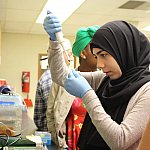
Innovation Through Diversity
Enhancing diversity in the NIH-funded workforce is urgent, given shifting U.S. demographics and the need to draw insights from all corners of America.
« Previous: A Healthy Mind Next: Transformative Technologies »
This page last reviewed on November 16, 2023
Connect with Us
- More Social Media from NIH
Helping you turn great ideas into real world outcomes
Envisioning the future of research
To help you fulfill your goals in a landscape of increasing competition and complexity, Web of Science TM is building advanced resources and tools designed to accelerate the pace of discovery, increase the transparency and visibility of open research, better support strategic funding and investment decisions, and facilitate wider and deeper collaborations across the research community.
Listen to our podcast series to learn more about trends impacting the global research landscape, and how the Web of Science can help you successfully navigate them. We’ll release a new episode here each week, beginning mid-October, 2020.
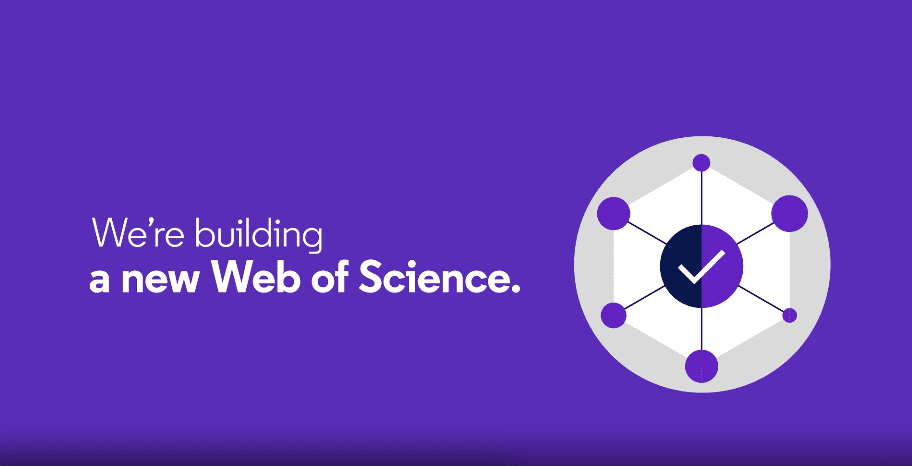
How open science is transforming the future of research
Dr. Nandita Quaderi, Web of Science Editor-in-Chief, discusses the drivers behind open research and shares our plans for expanding the content types available in the Web of Science to help you save time navigating the complex open research ecosystem.
Listen to the podcast
The changing nature of international collaboration
Dr. Jonathan Adams, Chief Scientist at the Institute for Scientific Information, shares insights into the current collaborations landscape drawn from his decades of experience analyzing patterns of global collaboration across academic, government and corporate institutions.
Meeting researchers at their point of need to accelerate discovery
Dr. Rob Poolman, Vice President of the Web of Science Product Platform, and Nina Chang, Web of Science Product Manager, discuss how the global pandemic has impacted researchers at all career stages, and how we’re investing to create the most powerful Web of Science platform yet to deliver what you need when you need it, wherever you are.
Demonstrating real-world outcomes and the future of research evaluation
Dr. Martin Szomszor, Director of the Institute for Scientific Information, and Josh Schnell, Consultancy Director, discuss current challenges research evaluators face, share insights into best practices for measuring the real-world outcomes of research, and talk about new indicators and predictive methodologies on the horizon.
Related content
Introducing the new Web of Science
Learn about the improvements we are making to the Web of Science.
New Web of Science strategy
Transforming the Web of Science into a dynamic – and highly personal – research intelligence platform
Product Advisory Group
Join our Web of Science Product Advisory Group.
Get in touch to see how the Web of Science can help you access, connect and gain insight from your research.
What is 'futures studies' and how can it help us improve our world?

A futurist explains.
.chakra .wef-1c7l3mo{-webkit-transition:all 0.15s ease-out;transition:all 0.15s ease-out;cursor:pointer;-webkit-text-decoration:none;text-decoration:none;outline:none;color:inherit;}.chakra .wef-1c7l3mo:hover,.chakra .wef-1c7l3mo[data-hover]{-webkit-text-decoration:underline;text-decoration:underline;}.chakra .wef-1c7l3mo:focus,.chakra .wef-1c7l3mo[data-focus]{box-shadow:0 0 0 3px rgba(168,203,251,0.5);} Abhinav Chugh

.chakra .wef-9dduvl{margin-top:16px;margin-bottom:16px;line-height:1.388;font-size:1.25rem;}@media screen and (min-width:56.5rem){.chakra .wef-9dduvl{font-size:1.125rem;}} Explore and monitor how .chakra .wef-15eoq1r{margin-top:16px;margin-bottom:16px;line-height:1.388;font-size:1.25rem;color:#F7DB5E;}@media screen and (min-width:56.5rem){.chakra .wef-15eoq1r{font-size:1.125rem;}} Innovation is affecting economies, industries and global issues

.chakra .wef-1nk5u5d{margin-top:16px;margin-bottom:16px;line-height:1.388;color:#2846F8;font-size:1.25rem;}@media screen and (min-width:56.5rem){.chakra .wef-1nk5u5d{font-size:1.125rem;}} Get involved with our crowdsourced digital platform to deliver impact at scale
Stay up to date:.
Listen to the article
- Futures studies is the systematic study of possible, probable and preferable futures.
- It can be used to help leaders and communities manage uncertainties and increase their resilience and innovation.
- We spoke with futurist Dr. Stuart Candy about the latest developments in this field and how it can help us solve pressing global challenges.
Futures studies, or futures research, is the systematic study of possible, probable and preferable futures. The field has broadened into an exploration of alternative futures and deepened to investigate the worldviews and mythologies that underlie our collective prospects.
Governments and leaders around the world are increasingly looking to systemic foresight to manage uncertainty and build resilience. For example, the government of the United Arab Emirates has a Ministry for the Future , and the UN Secretary General recently proposed a global Summit of the Future in 2023.
Futurists collaborate with businesses, governments and other partners to explore future scenarios and help people think about –– and prepare for –– things that haven’t happened yet. Dr. Stuart Candy, USC Berggruen Fellow and Associate Professor of Design at Carnegie Mellon University, is a professional futurist and experience designer known for pioneering experiential futures , a range of practices for bringing possible scenarios to life through tangible artifacts and immersive storytelling.
As we welcome Dr. Candy into the Forum Expert Network , we discuss his motivations to explore this domain, what developments have him most excited, what he wishes people knew about his work, and how we could make the concept of the future more inclusive and accountable.
What drew you to the field of foresight and speculative design?
I happened across the foresight field, or futures studies, back in high school. It was immediately inspiring to me –– wide-ranging and imaginative, analytically insightful, ethically engaged and practically applied. However, over some years of working with foresight in government, I found that policymakers had limited capacity to envision alternative futures, and even where the field had a certain currency, its legacy methods weren’t necessarily having great impact.
So, I began re-visiting longstanding creative interests of mine that had perhaps begun to fall away during my formal education in history and law –– making things, films, theatre, games –– and asked: how might thinking about futures be made more accessible and compelling through these modes?
What began as a trickle has, over time, become more like a flood: practitioners, scholars, activists, and others around the world are now working in countless different ways on these intersections. A range of these are documented in our recent collection Design and Futures .
What global challenge does your work address?
The central challenge this work addresses could certainly be called global, but equally, it's psychological. It is an aspect of the human condition that exists at every scale of action and institution, from the personal to the planetary. That challenge is: how to engage the various possible worlds we might find ourselves in later –– not just intellectually, in the abstract, but more deeply as potential lived realities? The field traditionally has been very strong on frameworks for organizing thought, but less so on converting those anticipations into embodied insights and making them stick.
Design and futures were largely non-overlapping worlds when we started joining the dots in the mid-2000s, and a decade ago, the term "speculative design" wasn’t even in the mix. However, new framings that speak to different groups are part of the vitality of how the work has taken off, and I’m glad to help people explore futures more effectively under any banner. I have now spent well over a decade bringing futures often into new spaces, especially by growing and gardening those connections between foresight and media, arts, and design, which is intended to help acculturate –– build into our cultures –– these ways of thinking.
I would add that to my mind, designers have special duties because they create fragments of the future on behalf of everyone. Similarly, to the extent that a leader in any context has an outsized capacity to shape things, they have a commensurate responsibility to practice and enable high quality futures thinking.
What is the most critical challenge that you face as a futurist?
Perhaps the most critical challenge is the need for futures literacy in the culture. Take politics and journalism, institutions that inherently deal with the future but that do not have a well-established habit of " rigorous imagining ". Lack of futures literacy is apparent when otherwise discerning journalists demand that you provide predictions for their piece on "the future" (note the singular form) of any issue they are covering.
It is also apparent when policymakers, technologists, pundits, and other public figures issue a constant stream of authoritative-sounding forecasts, but no one checks back later to see how they fared, or asks how this diet of images of the future might be exerting influence and serving some interests more than others. Raising collective futures literacy, or "social foresight", not just across organizations but also throughout society, is an essential way for us all to navigate the predicaments that we face as a species.
What is the most exciting new development in collective foresight and why?
The greatest development right now is the rapid widening of those who initiate, run, and take part in foresight work. It’s incredibly exciting. People in various sectors, bringing diverse cultural, organizational, and disciplinary backgrounds and sensibilities, are picking up the tools to build strategic foresight and experiential futures approaches in particular, and adapting them for their own contexts and needs.
There’s more participation and interest than there has ever been, which is as thrilling as it is overdue. Organization leaders and governments, too, are taking the cue to improve their foresight approaches which is necessary in this time.
How are emerging technologies in the sphere of media (such as AR/VR) enabling this?
Playing with emerging media tools and technologies is a fun and productive aspect of opening up new ways of thinking through experiential futures. For instance, for the World Economic Forum’s own Global Technology Governance Summit this year, with my Carnegie Mellon students we designed online media –– websites and podcasts that behaved as if they were "from" decades out, each examining technology governance dilemmas and interventions that might be waiting in the wings.
Another project, for the UNESCO Futures Summit, pictured a future after the Sustainable Development Goals are achieved, via a digital showcase of world-changing organizations and initiatives in the year 2045. Here, we created a digital trade show for visitors to wander and explore at their leisure, using an online collaboration software Miro . Earlier this year, we created TikToks from the future , just as an experiment. The result was a range of wonderfully mundane, sometimes provocative or hilarious, vignettes of everyday futures, made with zero budget, and exploring food, autonomous vehicles, real estate, travel, and more.
Yet, the medium itself does not necessarily need to be cutting-edge or experimental to be effective. To support the UN Development Programme’s annual innovation gathering, mid-pandemic, my collaborators and I created physical artifacts from alternative futures for global development and sent them in the mail for people to receive at their homes, ahead of a global event that took place entirely online.
Every storytelling approach offers different ways to think and feel into what alternative scenarios might be like. Since no one can visit the future to get hard information about it, we must use whatever it takes to stoke our collective imaginative and deliberative capacities.
What is most misunderstood about your work? What do you wish people knew?
The role of a futurist is more like that of an artist or writer than an accountant or lawyer. It’s as much an art or craft as a profession, and there are as many kinds of futurists as there are ways of thinking about the future. The tradition I identify with is notable for being radically imaginative, critical, inclusive, and democratic. And to me, taking words like "future" and "futurist" back from the ways they have been abused, pre-populated or colonized with a tremendous amount of baggage is part of the project in hand.
It could also be helpful for more people to be aware that experts in the field generally don’t call it " futurism " –– that word refers more to an art movement early last century that’s unrelated.
What has been the biggest impact of mapping futures?
Building the habit of mapping futures can be life changing. For institutions or organizations, it can really shift how they operate. Likewise at an individual level –– and it’s remarkable to get to see this among my students. I think a reason it can have such impact is that it’s a way of situating the "what" and "how" of daily effort within the larger "whys" in our lives. Investing in foresight capacity helps to knit vital day-to-day work to the meaningful longer-term and bigger-picture questions, and to keep those ties alive.
I believe the biggest collective impact of all this is unfolding right before our eyes, but it’s a large story, so you must look for it on a timescale of decades or generations rather than months or years. We, as humans, are learning how to codesign our futures. This is ultimately a transformation in culture and governance.
How can we democratize futures studies and make it more accessible?
Well, I love that question. It’s central to what we have been up to. My own approach to developing and socializing experiential futures widely has been to keep several hats at the ready, sometimes wearing more than one at once. As a creative, I devise projects and interventions to make particular questions, and new horizons of thought, available for particular occasions and audiences
As an educator, I learn from these experiments to devise new frameworks, and distribute them to emerging practitioners and whoever else can use them in their own context. And as a strategic consultant, I collaborate with organizations, governments and communities on their challenges to apply what we are learning, and show how it can work, which helps address those challenges while also earning greater legitimacy and visibility on behalf of a wider futures community, growing the audience of users and learners for the underlying practices.
If you’re wondering about what a broader "we" can do, just about every organization has potential to grow their foresight capacity , and make more space to engage with alternative futures, which can help support creativity and innovation on one hand as well as risk mitigation and resilience on the other.
One project we’ve developed over some years which I think exemplifies this hybrid activity rather well, is a card deck called The Thing From The Future . It’s a tool for diversifying and deepening imagination. We’ve used it with UN agencies and the International Red Cross, as well as the BBC, NASA JPL, US Conference of Mayors, Skoll World Forum and other partners all over the world. It is a game that has the purpose of lowering the bar to using imagination with skill, and having conversations that matter, but playfully.
The future is not just something that happens to us, it is something we have the ability to shape. And part of what is interesting is, the more people and institutions tune in, participate, and act, the truer this becomes.
Don't miss any update on this topic
Create a free account and access your personalized content collection with our latest publications and analyses.
License and Republishing
World Economic Forum articles may be republished in accordance with the Creative Commons Attribution-NonCommercial-NoDerivatives 4.0 International Public License, and in accordance with our Terms of Use.
The views expressed in this article are those of the author alone and not the World Economic Forum.
Related topics:
The agenda .chakra .wef-n7bacu{margin-top:16px;margin-bottom:16px;line-height:1.388;font-weight:400;} weekly.
A weekly update of the most important issues driving the global agenda
.chakra .wef-1dtnjt5{display:-webkit-box;display:-webkit-flex;display:-ms-flexbox;display:flex;-webkit-align-items:center;-webkit-box-align:center;-ms-flex-align:center;align-items:center;-webkit-flex-wrap:wrap;-ms-flex-wrap:wrap;flex-wrap:wrap;} More on Emerging Technologies .chakra .wef-nr1rr4{display:-webkit-inline-box;display:-webkit-inline-flex;display:-ms-inline-flexbox;display:inline-flex;white-space:normal;vertical-align:middle;text-transform:uppercase;font-size:0.75rem;border-radius:0.25rem;font-weight:700;-webkit-align-items:center;-webkit-box-align:center;-ms-flex-align:center;align-items:center;line-height:1.2;-webkit-letter-spacing:1.25px;-moz-letter-spacing:1.25px;-ms-letter-spacing:1.25px;letter-spacing:1.25px;background:none;padding:0px;color:#B3B3B3;-webkit-box-decoration-break:clone;box-decoration-break:clone;-webkit-box-decoration-break:clone;}@media screen and (min-width:37.5rem){.chakra .wef-nr1rr4{font-size:0.875rem;}}@media screen and (min-width:56.5rem){.chakra .wef-nr1rr4{font-size:1rem;}} See all

Solar storms hit tech equipment, and other technology news you need to know
Sebastian Buckup
May 17, 2024

Generative AI is trained on just a few of the world’s 7,000 languages. Here’s why that’s a problem – and what’s being done about it
Madeleine North

Critical minerals demand has doubled in the past five years – here are some solutions to the supply crunch
Emma Charlton
May 16, 2024

6 ways satellites are helping to monitor our changing planet from space
Andrea Willige

How can GenAI be optimized for people and processes?
May 15, 2024

This is how AI can empower women and achieve gender equality, according to the founder of Girls Who Code and Moms First
Kate Whiting
May 14, 2024

Empowering Early Career Researchers
Future of Research champions, engages, and empowers early career researchers (ECRs) with evidence-based resources to make informed career choices and improve scientific research.
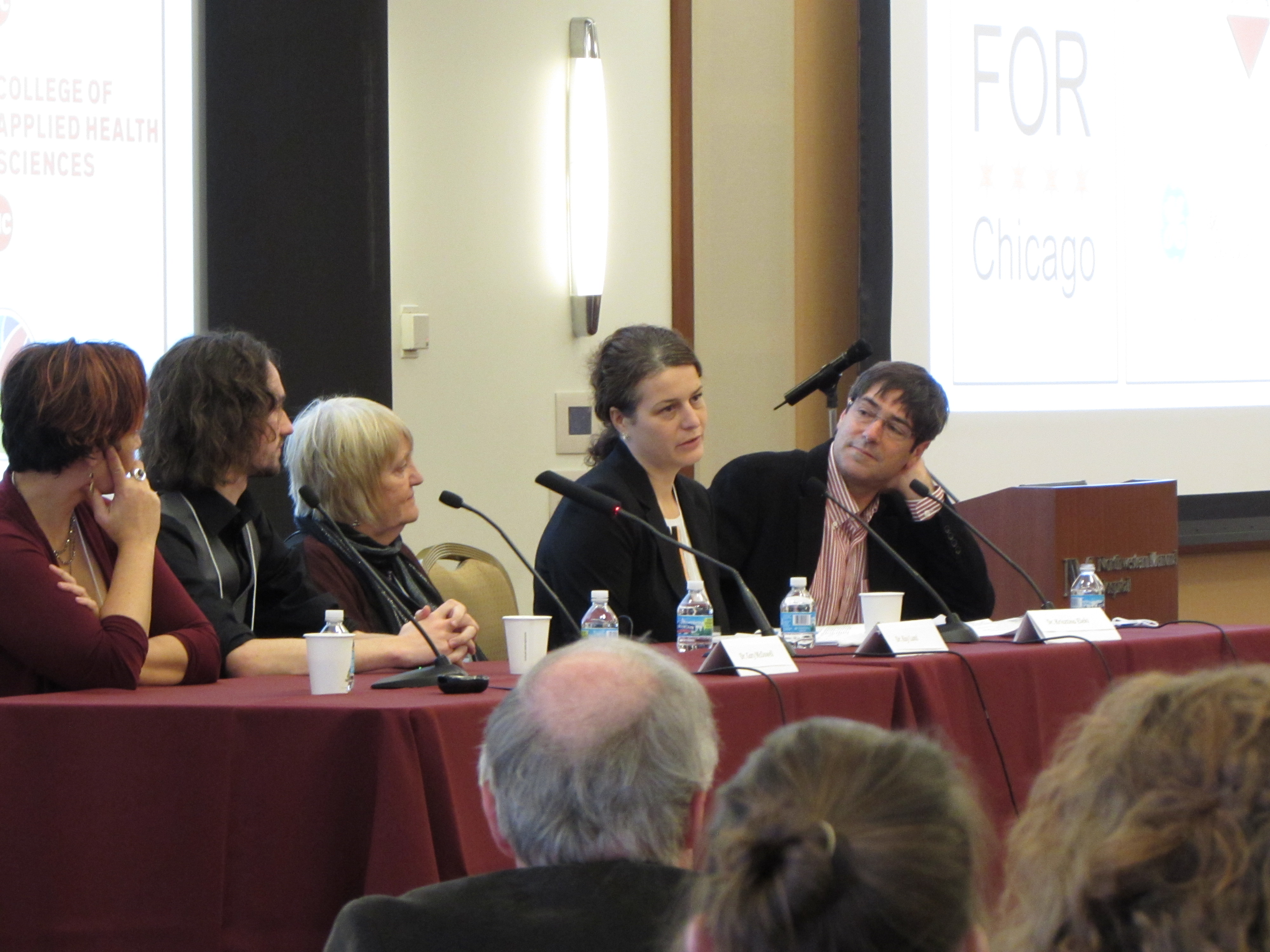
Our Mission
We share resources, community, and expertise with those dedicated to advocacy work and the improvement of academic training environments.
Our projects
We promote grassroots advocacy, currently focusing on three specific projects. Click on each below to see how you can get involved.
Mentoring future scientists
Departmental or training program policies have a huge impact on the success of graduate students, postdocs, and scientific endeavors.
We convened experts and early career researchers to define major policy guidelines and excellence tiers for STEM departments.
Labor and policy
Graduate students, postdoctoral researchers and research associates are among groups of academics searchers across the U.S. organizing, or participating in, unionization efforts and votes. Read our statement and review resources for unionization
international scholars
We raise awareness about the challenges faced by foreign-born researchers currently employed in US academic institutions and advocate for their needs by collecting data, disseminating findings to broad audiences.
Our leadership in action
Learn more about the importance of mentorship and resources in early career research from a Future of Research President, Fatima Sanchenznieto at TedX Chicago.
Latest News
Our blog posts keep you informed of overall organization news as well as with statements that that Future of Research develops as part of our advocacy to better empower ECRs.
Science Policy in our New Administration: Challenges Facing Early Career Researchers
by futureofresearch | Feb 7, 2021
In the week before he was sworn in as the 46th President of the United States, then President-elect Biden took the unprecedented step of elevating the director of the Office of Science and Technology Policy (OSTP) to a cabinet level position. In doing so, Biden...
Police Brutality, Racism, and the killing of Black civilians
by Fátima Sancheznieto | Jun 5, 2020
Dear Future of Research Community, At a time when there is a continued need for as much collective grieving as there is for concrete actions, writing a statement can feel hollow. When so many in the Black community, on a regular basis, decry the systemic,...
U.S. Senate Finance Committee meeting on foreign influences highlights federal agency urgency without clarity
by Gary McDowell | Jun 7, 2019
On Wednesday, the United States Senate Finance Committee met to discuss Foreign Threats to Taxpayer – Funded Research: Oversight Opportunities and Policy Solutions. The webpage includes a video of the session (which begins approximately 30 mins in) and written...
6 priorities for future research into COVID-19 and its effects on early learning
Subscribe to the brown center on education policy newsletter, christina weiland , christina weiland associate professor, school of education - university of michigan @weilanch erica greenberg , erica greenberg senior research associate, center on education data and policy - urban institute @ericahgreenberg daphna bassok , daphna bassok nonresident senior fellow - governance studies , brown center on education policy @daphnabassok anna j. markowitz , anna j. markowitz assistant professor, graduate school of education and information studies - ucla @ajmarkowitz paola guerrero rosada , and paola guerrero rosada doctoral candidate, school of education - university of michigan @paolaguerreror grace luetmer grace luetmer research analyst, center on education data and policy - urban institute @graceluetmer.
July 20, 2021
Since March 2020, researchers have produced more than 300 reports on the effects of the COVID-19 crisis on young children’s learning and on the early care and education (ECE) programs that serve them. Very quickly, ECE leaders facing the urgent day-to-day demands of COVID-19 response also faced a deluge of evidence—far more than they could efficiently find, sort, and use.
To help provide policymakers with a clear understanding of the pandemic’s effects on young children’s learning and ECE programs, our team of 16 early childhood experts and 10 early childhood policy leaders recently released a summary of this evidence base. We reviewed 76 high-quality studies in depth, spanning 16 national studies, 45 studies in 31 states, and 15 local studies. Our work illuminated a national story of learning setbacks and unmet needs, for which we offered evidence-backed, equity-centered policy solutions.
But another advantage of taking stock of what we know was discovering what we don’t know. Our in-depth review revealed six takeaways about where research in this area should go next. Especially given that American Rescue Plan funds can be used to build research capacity in state and local agencies, our hope is that a clear statement of what stakeholders need to know next is helpful for producing new evidence to guide investments going forward.
Here are six priorities for future research going forward:
- Continue to track recovery for children, families, teachers, and programs. We likely have just scratched the surface of the effects of this fluid, complex crisis. The Delta variant raises new questions about health and safety, and young children have yet to be vaccinated . Extending studies of the effects of the crisis on children’s learning, the supply of ECE programs, and early educators’ experiences is essential for targeting supports and ensuring equitable solutions.
- Document changes to ECE programs and children’s experiences that are not captured in existing data. We have lots of evidence that shows the many changes ECE programs made to enhance health and safety, but we have only crude teacher reports on the effects of these changes on children’s classroom experiences. As vaccination rates increase, a return to direct observations of ECE classrooms—commonly done at large scale prior to the crisis—should be used to support both children and teachers. How are young children spending their time? Has instructional quality declined as teacher reports indicate? In what areas do teachers need support? Widely used and newer measures can answer these questions and inform instructional and policy decisions in the new normal.
- Measure learning outcomes for the youngest learners directly and across multiple domains. We found no data from direct assessments of children’s skills prior to kindergarten, and very little data outside of the literacy domain for kindergarten through second grade. We have parent and teacher reports on the youngest children that paint a worrisome picture, but the psychometrics of such measures can be questionable. The K-2 direct assessments we have show consistent and large learning setbacks, particularly for children typically marginalized in the U.S. education system. And many children, especially children from households with low incomes and children of color, are missing from recent data. Direct assessments are critical for meeting young children where they are, targeting resources effectively, and guiding investment decisions.
- Collect systematic data on the ECE workforce. Many studies have detailed how the ECE workforce suffered in the crisis, with the pandemic magnifying longstanding issues like very low pay, limited benefits, and few professional supports, particularly among teachers in child care and family child care settings. In the face of new challenges, early educators also reported new professional-development needs, including training on health and safety, remote learning, and meeting the needs of dual language learners (DLLs). Unlike in K-12, where extensive data is collected about the teaching workforce, few states systematically collect data about early educators. Collecting such data across sectors will be essential as new investments are made. ECE workforce issues commonly undercut investments and early educators are at the heart of ensuring the high-quality experiences that help young children thrive.
- Prioritize research on groups hit hardest. We know the effects of the pandemic have not been borne equally , but we found no data on some key populations such as young children from homeless families, children experiencing bereavement, children from migrant families, and Asian-American children amid the spike in Asian-American hate. Data on other critical populations like DLLs, children with disabilities, and Native-American children are sparse. Equity-centered, evidence-backed decision-making requires more data on young children who belong to groups that have suffered more in the crisis.
- Evaluate the impacts of new investments. We will need additional rigorous, fast-turnaround research as states and localities make high-stakes policy and spending decisions and families make decisions about their children’s care and education in the next chapter of the crisis. Decisions on a set of wide-ranging topics (e.g., program eligibility, teacher compensation and professional supports, and interventions for students needing help) both provide unique opportunities to study bold policy and have the potential to make lasting impacts. As an example, Gov. Gretchen Whitmer in Michigan—a state hit particularly hard by the crisis—recently announced historic investments in both child care and preschool , including expanding access and improving teacher pay. Maine and Washington state also announced important new investments. Documenting state and local policy choices and their impacts is essential. Doing so will help legislartors make decisions about how best to allocate recovery dollars, and will ensure that what we learn from these historic investments will inform longer-term efforts to build truly high-quality ECE systems.
We titled our summary : “Historic crisis, historic opportunity.” The March 2021 American Rescue Plan was the largest public investment in early care and education in U.S. history. Smart and rigorous research, especially in partnership with decision-makers, has a critical role to play in pivoting from crisis to opportunity in ECE. Our young children and early educators deserve no less.
Related Content
Anita McGinty, Ann Partee, Allison Lynn Gray, Walter Herring, Jim Soland
July 19, 2021
Daphna Bassok, Lauren Bauer, Stephanie Riegg Cellini, Helen Shwe Hadani, Michael Hansen, Douglas N. Harris, Brad Olsen, Richard V. Reeves, Jon Valant, Kenneth K. Wong
March 12, 2021
Early Childhood Education
Governance Studies
Brown Center on Education Policy
Annelies Goger, Katherine Caves, Hollis Salway
May 16, 2024
Sofoklis Goulas, Isabelle Pula
Melissa Kay Diliberti, Elizabeth D. Steiner, Ashley Woo
An official website of the United States government
The .gov means it's official. Federal government websites often end in .gov or .mil. Before sharing sensitive information, make sure you're on a federal government site.
The site is secure. The https:// ensures that you are connecting to the official website and that any information you provide is encrypted and transmitted securely.
- Publications
- Account settings
- Browse Titles
NCBI Bookshelf. A service of the National Library of Medicine, National Institutes of Health.
Evans D, Coad J, Cottrell K, et al. Public involvement in research: assessing impact through a realist evaluation. Southampton (UK): NIHR Journals Library; 2014 Oct. (Health Services and Delivery Research, No. 2.36.)

Public involvement in research: assessing impact through a realist evaluation.
Chapter 9 conclusions and recommendations for future research.
- How well have we achieved our original aim and objectives?
The initially stated overarching aim of this research was to identify the contextual factors and mechanisms that are regularly associated with effective and cost-effective public involvement in research. While recognising the limitations of our analysis, we believe we have largely achieved this in our revised theory of public involvement in research set out in Chapter 8 . We have developed and tested this theory of public involvement in research in eight diverse case studies; this has highlighted important contextual factors, in particular PI leadership, which had not previously been prominent in the literature. We have identified how this critical contextual factor shapes key mechanisms of public involvement, including the identification of a senior lead for involvement, resource allocation for involvement and facilitation of research partners. These mechanisms then lead to specific outcomes in improving the quality of research, notably recruitment strategies and materials and data collection tools and methods. We have identified a ‘virtuous circle’ of feedback to research partners on their contribution leading to their improved confidence and motivation, which facilitates their continued contribution. Following feedback from the HS&DR Board on our original application we did not seek to assess the cost-effectiveness of different mechanisms of public involvement but we did cost the different types of public involvement as discussed in Chapter 7 . A key finding is that many research projects undercost public involvement.
In our original proposal we emphasised our desire to include case studies involving young people and families with children in the research process. We recruited two studies involving parents of young children aged under 5 years, and two projects involving ‘older’ young people in the 18- to 25-years age group. We recognise that in doing this we missed studies involving children and young people aged under 18 years; in principle we would have liked to have included studies involving such children and young people, but, given the resources at our disposal and the additional resource, ethical and governance issues this would have entailed, we regretfully concluded that this would not be feasible for our study. In terms of the four studies with parental and young persons’ involvement that we did include, we have not done a separate analysis of their data, but the themes emerging from those case studies were consistent with our other case studies and contributed to our overall analysis.
In terms of the initial objectives, we successfully recruited the sample of eight diverse case studies and collected and analysed data from them (objective 1). As intended, we identified the outcomes of involvement from multiple stakeholders‘ perspectives, although we did not get as many research partners‘ perspectives as we would have liked – see limitations below (objective 2). It was more difficult than expected to track the impact of public involvement from project inception through to completion (objective 3), as all of our projects turned out to have longer time scales than our own. Even to track involvement over a stage of a case study research project proved difficult, as the research usually did not fall into neatly staged time periods and one study had no involvement activity over the study period.
Nevertheless, we were able to track seven of the eight case studies prospectively and in real time over time periods of up to 9 months, giving us an unusual window on involvement processes that have previously mainly been observed retrospectively. We were successful in comparing the contextual factors, mechanisms and outcomes associated with public involvement from different stakeholders‘ perspectives and costing the different mechanisms for public involvement (objective 4). We only partly achieved our final objective of undertaking a consensus exercise among stakeholders to assess the merits of the realist evaluation approach and our approach to the measurement and valuation of economic costs of public involvement in research (objective 5). A final consensus event was held, where very useful discussion and amendment of our theory of public involvement took place, and the economic approach was discussed and helpfully critiqued by participants. However, as our earlier discussions developed more fully than expected, we decided to let them continue rather than interrupt them in order to run the final exercise to assess the merits of the realist evaluation approach. We did, however, test our analysis with all our case study participants by sending a draft of this final report for comment. We received a number of helpful comments and corrections but no disagreement with our overall analysis.
- What were the limitations of our study?
Realist evaluation is a relatively new approach and we recognise that there were a number of limitations to our study. We sought to follow the approach recommended by Pawson, but we acknowledge that we were not always able to do so. In particular, our theory of public involvement in research evolved over time and initially was not as tightly framed in terms of a testable hypothesis as Pawson recommends. In his latest book Pawson strongly recommends that outcomes should be measured with quantitative data, 17 but we did not do so; we were not aware of the existence of quantitative data or tools that would enable us to collect such data to answer our research questions. Even in terms of qualitative data, we did not capture as much information on outcomes as we initially envisaged. There were several reasons for this. The most important was that capturing outcomes in public involvement is easier the more operational the focus of involvement, and more difficult the more strategic the involvement. Thus, it was relatively easy to see the impact of a patient panel on the redesign of a recruitment leaflet but harder to capture the impact of research partners in a multidisciplinary team discussion of research design.
We also found it was sometimes more difficult to engage research partners as participants in our research than researchers or research managers. On reflection this is not surprising. Research partners are generally motivated to take part in research relevant to their lived experience of a health condition or situation, whereas our research was quite detached from their lived experience; in addition people had many constraints on their time, so getting involved in our research as well as their own was likely to be a burden too far for some. Researchers clearly also face significant time pressures but they had a more direct interest in our research, as they are obliged to engage with public involvement to satisfy research funders such as the NIHR. Moreover, researchers were being paid by their employers for their time during interviews with us, while research partners were not paid by us and usually not paid by their research teams. Whatever the reasons, we had less response from research partners than researchers or research managers, particularly for the third round of data collection; thus we have fewer data on outcomes from research partners‘ perspectives and we need to be aware of a possible selection bias towards more engaged research partners. Such a bias could have implications for our findings; for example payment might have been a more important motivating factor for less engaged advisory group members.
There were a number of practical difficulties we encountered. One challenge was when to recruit the case studies. We recruited four of our eight case studies prior to the full application, but this was more than 1 year before our project started and 15 months or more before data collection began. In this intervening period, we found that the time scales of some of the case studies were no longer ideal for our project and we faced the choice of whether to continue with them, although this timing was not ideal, or seek at a late moment to recruit alternative ones. One of our case studies ultimately undertook no involvement activity over the study period, so we obtained fewer data from it, and it contributed relatively little to our analysis. Similarly, one of the four case studies we recruited later experienced some delays itself in beginning and so we had a more limited period for data collection than initially envisaged. Research governance approvals took much longer than expected, particularly as we had to take three of our research partners, who were going to collect data within NHS projects, through the research passport process, which essentially truncated our data collection period from 1 year to 9 months. Even if we had had the full year initially envisaged for data collection, our conclusion with hindsight was that this was insufficiently long. To compare initial plans and intentions for involvement with the reality of what actually happened required a longer time period than a year for most of our case studies.
In the light of the importance we have placed on the commitment of PIs, there is an issue of potential selection bias in the recruitment of our sample. As our sampling strategy explicitly involved a networking approach to PIs of projects where we thought some significant public involvement was taking place, we were likely (as we did) to recruit enthusiasts and, at worst, those non-committed who were at least open to the potential value of public involvement. There were, unsurprisingly, no highly sceptical PIs in our sample. We have no data therefore on how public involvement may work in research where the PI is sceptical but may feel compelled to undertake involvement because of funder requirements or other factors.
- What would we do differently next time?
If we were to design this study again, there are a number of changes we would make. Most importantly we would go for a longer time period to be able to capture involvement through the whole research process from initial design through to dissemination. We would seek to recruit far more potential case studies in principle, so that we had greater choice of which to proceed with once our study began in earnest. We would include case studies from the application stage to capture the important early involvement of research partners in the initial design period. It might be preferable to research a smaller number of case studies, allowing a more in-depth ethnographic approach. Although challenging, it would be very informative to seek to sample sceptical PIs. This might require a brief screening exercise of a larger group of PIs on their attitudes to and experience of public involvement.
The economic evaluation was challenging in a number of ways, particularly in seeking to obtain completed resource logs from case study research partners. Having a 2-week data collection period was also problematic in a field such as public involvement, where activity may be very episodic and infrequent. Thus, collecting economic data alongside other case study data in a more integrated way, and particularly with interviews and more ethnographic observation of case study activities, might be advantageous. The new budgeting tool developed by INVOLVE and the MHRN may provide a useful resource for future economic evaluations. 23
We have learned much from the involvement of research partners in our research team and, although many aspects of our approach worked well, there are some things we would do differently in future. Even though we included substantial resources for research partner involvement in all aspects of our study, we underestimated how time-consuming such full involvement would be. We were perhaps overambitious in trying to ensure such full involvement with the number of research partners and the number and complexity of the case studies. We were also perhaps naive in expecting all the research partners to play the same role in the team; different research partners came with different experiences and skills, and, like most of our case studies, we might have been better to be less prescriptive and allow the roles to develop more organically within the project.
- Implications for research practice and funding
If one of the objectives of R&D policy is to increase the extent and effectiveness of public involvement in research, then a key implication of this research is the importance of influencing PIs to value public involvement in research or to delegate to other senior colleagues in leading on involvement in their research. Training is unlikely to be the key mechanism here; senior researchers are much more likely to be influenced by peers or by their personal experience of the benefits of public involvement. Early career researchers may be shaped by training but again peer learning and culture may be more influential. For those researchers sceptical or agnostic about public involvement, the requirement of funders is a key factor that is likely to make them engage with the involvement agenda. Therefore, funders need to scrutinise the track record of research teams on public involvement to ascertain whether there is any evidence of commitment or leadership on involvement.
One of the findings of the economic analysis was that PIs have consistently underestimated the costs of public involvement in their grant applications. Clearly the field will benefit from the guidance and budgeting tool recently disseminated by MHRN and INVOLVE. It was also notable that there was a degree of variation in the real costs of public involvement and that effective involvement is not necessarily costly. Different models of involvement incur different costs and researchers need to be made aware of the costs and benefits of these different options.
One methodological lesson we learned was the impact that conducting this research had on some participants’ reflection on the impact of public involvement. Particularly for research staff, the questions we asked sometimes made them reflect upon what they were doing and change aspects of their approach to involvement. Thus, the more the NIHR and other funders can build reporting, audit and other forms of evaluation on the impact of public involvement directly into their processes with PIs, the more likely such questioning might stimulate similar reflection.
- Recommendations for further research
There are a number of gaps in our knowledge around public involvement in research that follow from our findings, and would benefit from further research, including realist evaluation to extend and further test the theory we have developed here:
- In-depth exploration of how PIs become committed to public involvement and how to influence agnostic or sceptical PIs would be very helpful. Further research might compare, for example, training with peer-influencing strategies in engendering PI commitment. Research could explore the leadership role of other research team members, including research partners, and how collective leadership might support effective public involvement.
- More methodological work is needed on how to robustly capture the impact and outcomes of public involvement in research (building as well on the PiiAF work of Popay et al. 51 ), including further economic analysis and exploration of impact when research partners are integral to research teams.
- Research to develop approaches and carry out a full cost–benefit analysis of public involvement in research would be beneficial. Although methodologically challenging, it would be very useful to conduct some longer-term studies which sought to quantify the impact of public involvement on such key indicators as participant recruitment and retention in clinical trials.
- It would also be helpful to capture qualitatively the experiences and perspectives of research partners who have had mixed or negative experiences, since they may be less likely than enthusiasts to volunteer to participate in studies of involvement in research such as ours. Similarly, further research might explore the (relatively rare) experiences of marginalised and seldom-heard groups involved in research.
- Payment for public involvement in research remains a contested issue with strongly held positions for and against; it would be helpful to further explore the value research partners and researchers place on payment and its effectiveness for enhancing involvement in and impact on research.
- A final relatively narrow but important question that we identified after data collection had finished is: what is the impact of the long periods of relative non-involvement following initial periods of more intense involvement for research partners in some types of research, particularly clinical trials?
Included under terms of UK Non-commercial Government License .
- Cite this Page Evans D, Coad J, Cottrell K, et al. Public involvement in research: assessing impact through a realist evaluation. Southampton (UK): NIHR Journals Library; 2014 Oct. (Health Services and Delivery Research, No. 2.36.) Chapter 9, Conclusions and recommendations for future research.
- PDF version of this title (4.3M)
In this Page
Other titles in this collection.
- Health Services and Delivery Research
Recent Activity
- Conclusions and recommendations for future research - Public involvement in rese... Conclusions and recommendations for future research - Public involvement in research: assessing impact through a realist evaluation
Your browsing activity is empty.
Activity recording is turned off.
Turn recording back on
Connect with NLM
National Library of Medicine 8600 Rockville Pike Bethesda, MD 20894
Web Policies FOIA HHS Vulnerability Disclosure
Help Accessibility Careers

Futures Research
Futures research can be defined as a systematic study of possible future events and circumstances. As a field of study, futures evolved in 1950s. Futures research is different from forecasting in a way that the former has a forward orientation and looks ahead, rather that backwards, and is not as mathematical as forecasting.
It can be argued that highly dynamic nature of the contemporary global marketplace is making is difficult to conduct quality futures studies. For example, it is now evident that COVID-19 global pandemic has compromised findings of many futures studies. This is because no researcher could foresee the occurrence of extent of implications of pandemic on global business and economics.
Disadvantages of futures research are straightforward – no event or situation can be forecasted in an accurate and complete manner. Nevertheless, futures studies may offer a substantial advantage. Specifically, although futures studies are not able to produce totally accurate and complete information about the future, some researched information about the future is better than no information at all when engaging in decision making for long-term perspective.
There is wide range of techniques available that can be used to conduct futures studies. The following table illustrates types and techniques of the most popular futures techniques.
Futures research methods techniques
Source: Millenium Project
The nature of decision-making using the results of futures studies can be approached from four alternative perspectives:
1. Values perspective categorises forecasted outcome of events and occurrences as good or bad. Accordingly, value perspective tends to be highly subjective due to value differences amongst individuals.
2. Rational perspective relates to selection of an alternative amongst decision options guided by the extent to which each alternative meets certain criteria.
3. Judgement heuristics is associated with tendency towards risk-taking and relying on intuition when engaging in decision making.
4. Cognitive science perspective to decision making relies on inductive process of thought and taking decisions as a result of inductive analysis by individuals, as well as, related computer programs.
If you decide to conduct a futures research for your dissertation you will have to choose a specific method from table above. You will need to discuss advantages and disadvantages of the method selected and also provide rationale for the choice.
My e-book, The Ultimate Guide to Writing a Dissertation in Business Studies: a step by step assistance contains discussions of theory and application of research philosophy. The e-book also explains all stages of the research process starting from the selection of the research area to writing personal reflection. Important elements of dissertations such as research philosophy , research approach , research design , methods of data collection and data analysis are explained in this e-book in simple words.

[1] Source: Millenium Project
Featured Topics
Featured series.
A series of random questions answered by Harvard experts.
Explore the Gazette
Read the latest.

‘The scientist is not in the business of following instructions.’

Glimpse of next-generation internet

Epic science inside a cubic millimeter of brain

Venki Ramakrishnan.
Niles Singer/Harvard Staff Photographer
Science is making anti-aging progress. But do we want to live forever?
Nobel laureate details new book, which surveys research, touches on larger philosophical questions
Anne J. Manning
Harvard Staff Writer
Mayflies live for only a day. Galapagos tortoises can reach up to age 170. The Greenland shark holds the world record at over 400 years of life.
Venki Ramakrishnan, Nobel laureate and author of the newly released “ Why We Die: The New Science of Aging and the Quest for Immortality ,” opened his packed Harvard Science Book Talk last week by noting the vast variabilities of lifespans across the natural world. Death is certain, so far as we know. But there’s no physical or chemical law that says it must happen at a fixed time, which raises other, more philosophical issues.
The “why” behind these enormous swings, and the quest to harness longevity for humans, have driven fevered attempts (and billions of dollars in research spending) to slow or stop aging. Ramakrishnan’s book is a dispassionate journey through current scientific understanding of aging and death, which basically comes down to an accumulation of chemical damage to molecules and cells.
“The question is whether we can tackle aging processes, while still keeping us who we are as humans,” said Ramakrishnan during his conversation with Antonio Regalado, a writer for the MIT Technology Review. “And whether we can do that in a safe and effective way.”
Even if immortality — or just living for a very, very long time — were theoretically possible through science, should we pursue it? Ramakrishnan likened the question to other moral ponderings.
“There’s no physical or chemical law that says we can’t colonize other galaxies, or outer space, or even Mars,” he said. “I would put it in that same category. And it would require huge breakthroughs, which we haven’t made yet.”
In fact, we’re a lot closer to big breakthroughs when it comes to chasing immortality. Ramakrishnan noted the field is moving so fast that a book like his can capture but a snippet. He then took the audience on a brief tour of some of the major directions of aging research. And much of it, he said, started in unexpected places.
Take rapamycin, a drug first isolated in the 1960s from a bacterium on Easter Island found to have antifungal, immunosuppressant, and anticancer properties. Rapamycin targets the TOR pathway, a large molecular signaling cascade within cells that regulates many functions fundamental to life. Rapamycin has garnered renewed attention for its potential to reverse the aging process by targeting cellular signaling associated with physiological changes and diseases in older adults.
Other directions include mimicking the anti-aging effects of caloric restriction shown in mice, as well as one particularly exciting area called cellular reprogramming. That means taking fully developed cells and essentially turning back the clock on their development.
The most famous foundational experiment in this area was by Kyoto University scientist and Nobel laureate Shinya Yamanaka, who showed that just four transcription factors could revert an adult cell all the way back to a pluripotent stem cell, creating what are now known as induced pluripotent stem cells.
Ramakrishnan , a scientist at England’s MRC Laboratory of Molecular Biology, won the 2009 Nobel Prize in chemistry for uncovering the structure of the ribosome. He said he felt qualified to write the book because he has “no skin in the game” of aging research. As a molecular biologist who has studied fundamental processes of how cells make proteins, he had connections in the field but wasn’t too close to any of it.
While researching the book, he took pains to avoid interviewing scientists with commercial ventures tied to aging.
The potential for conflicts of interest abound.
The world has seen an explosion in aging research in recent decades, with billions of dollars spent by government agencies and private companies . And the consumer market for products is forecast to hit $93 billion by 2027 .
As a result, false or exaggerated claims by companies promising longer life are currently on the rise, Ramakrishnan noted. He shared one example: Supplements designed to lengthen a person’s telomeres, or genetic segments that shrink with age, are available on Amazon.
“Of course, these are not FDA approved. There are no clinical trials, and it’s not clear what their basis is,” he said.
But still there appears to be some demand.
Get the best of the Gazette delivered to your inbox
By subscribing to this newsletter you’re agreeing to our privacy policy
Share this article
You might like.
George Whitesides became a giant of chemistry by keeping it simple

Physicists demo first metro-area quantum computer network in Boston

Researchers publish largest-ever dataset of neural connections
Finding right mix on campus speech policies
Legal, political scholars discuss balancing personal safety, constitutional rights, academic freedom amid roiling protests, cultural shifts
Good genes are nice, but joy is better
Harvard study, almost 80 years old, has proved that embracing community helps us live longer, and be happier
- Privacy Policy

Home » Future Research – Thesis Guide
Future Research – Thesis Guide
Table of Contents

Future Research
Definition:
Future research refers to investigations and studies that are yet to be conducted, and are aimed at expanding our understanding of a particular subject or area of interest. Future research is typically based on the current state of knowledge and seeks to address unanswered questions, gaps in knowledge, and new areas of inquiry.
How to Write Future Research in Thesis
Here are some steps to help you write effectively about future research in your thesis :
- Identify a research gap: Before you start writing about future research, identify the areas that need further investigation. Look for research gaps and inconsistencies in the literature , and note them down.
- Specify research questions : Once you have identified a research gap, create a list of research questions that you would like to explore in future research. These research questions should be specific, measurable, and relevant to your thesis.
- Discuss limitations: Be sure to discuss any limitations of your research that may require further exploration. This will help to highlight the need for future research and provide a basis for further investigation.
- Suggest methodologies: Provide suggestions for methodologies that could be used to explore the research questions you have identified. Discuss the pros and cons of each methodology and how they would be suitable for your research.
- Explain significance: Explain the significance of the research you have proposed, and how it will contribute to the field. This will help to justify the need for future research and provide a basis for further investigation.
- Provide a timeline : Provide a timeline for the proposed research , indicating when each stage of the research would be conducted. This will help to give a sense of the practicalities involved in conducting the research.
- Conclusion : Summarize the key points you have made about future research and emphasize the importance of exploring the research questions you have identified.
Examples of Future Research in Thesis
SomeExamples of Future Research in Thesis are as follows:
Future Research:
Although this study provides valuable insights into the effects of social media on self-esteem, there are several avenues for future research that could build upon our findings. Firstly, our sample consisted solely of college students, so it would be beneficial to extend this research to other age groups and demographics. Additionally, our study focused only on the impact of social media use on self-esteem, but there are likely other factors that influence how social media affects individuals, such as personality traits and social support. Future research could examine these factors in greater depth. Lastly, while our study looked at the short-term effects of social media use on self-esteem, it would be interesting to explore the long-term effects over time. This could involve conducting longitudinal studies that follow individuals over a period of several years to assess changes in self-esteem and social media use.
While this study provides important insights into the relationship between sleep patterns and academic performance among college students, there are several avenues for future research that could further advance our understanding of this topic.
- This study relied on self-reported sleep patterns, which may be subject to reporting biases. Future research could benefit from using objective measures of sleep, such as actigraphy or polysomnography, to more accurately assess sleep duration and quality.
- This study focused on academic performance as the outcome variable, but there may be other important outcomes to consider, such as mental health or well-being. Future research could explore the relationship between sleep patterns and these other outcomes.
- This study only included college students, and it is unclear if these findings generalize to other populations, such as high school students or working adults. Future research could investigate whether the relationship between sleep patterns and academic performance varies across different populations.
- Fourth, this study did not explore the potential mechanisms underlying the relationship between sleep patterns and academic performance. Future research could investigate the role of factors such as cognitive functioning, motivation, and stress in this relationship.
Overall, there is a need for continued research on the relationship between sleep patterns and academic performance, as this has important implications for the health and well-being of students.
Further research could investigate the long-term effects of mindfulness-based interventions on mental health outcomes among individuals with chronic pain. A longitudinal study could be conducted to examine the sustainability of mindfulness practices in reducing pain-related distress and improving psychological well-being over time. The study could also explore the potential mediating and moderating factors that influence the relationship between mindfulness and mental health outcomes, such as emotional regulation, pain catastrophizing, and social support.
Purpose of Future Research in Thesis
Here are some general purposes of future research that you might consider including in your thesis:
- To address limitations: Your research may have limitations or unanswered questions that could be addressed by future studies. Identify these limitations and suggest potential areas for further research.
- To extend the research : You may have found interesting results in your research, but future studies could help to extend or replicate your findings. Identify these areas where future research could help to build on your work.
- To explore related topics : Your research may have uncovered related topics that were outside the scope of your study. Suggest areas where future research could explore these related topics in more depth.
- To compare different approaches : Your research may have used a particular methodology or approach, but there may be other approaches that could be compared to your approach. Identify these other approaches and suggest areas where future research could compare and contrast them.
- To test hypotheses : Your research may have generated hypotheses that could be tested in future studies. Identify these hypotheses and suggest areas where future research could test them.
- To address practical implications : Your research may have practical implications that could be explored in future studies. Identify these practical implications and suggest areas where future research could investigate how to apply them in practice.
Applications of Future Research
Some examples of applications of future research that you could include in your thesis are:
- Development of new technologies or methods: If your research involves the development of new technologies or methods, you could discuss potential applications of these innovations in future research or practical settings. For example, if you have developed a new drug delivery system, you could speculate about how it might be used in the treatment of other diseases or conditions.
- Extension of your research: If your research only scratches the surface of a particular topic, you could suggest potential avenues for future research that could build upon your findings. For example, if you have studied the effects of a particular drug on a specific population, you could suggest future research that explores the drug’s effects on different populations or in combination with other treatments.
- Investigation of related topics: If your research is part of a larger field or area of inquiry, you could suggest potential research topics that are related to your work. For example, if you have studied the effects of climate change on a particular species, you could suggest future research that explores the impacts of climate change on other species or ecosystems.
- Testing of hypotheses: If your research has generated hypotheses or theories, you could suggest potential experiments or studies that could test these hypotheses in future research. For example, if you have proposed a new theory about the mechanisms of a particular disease, you could suggest experiments that could test this theory in other populations or in different disease contexts.
Advantage of Future Research
Including future research in a thesis has several advantages:
- Demonstrates critical thinking: Including future research shows that the author has thought deeply about the topic and recognizes its limitations. It also demonstrates that the author is interested in advancing the field and is not satisfied with only providing a narrow analysis of the issue at hand.
- Provides a roadmap for future research : Including future research can help guide researchers in the field by suggesting areas that require further investigation. This can help to prevent researchers from repeating the same work and can lead to more efficient use of resources.
- Shows engagement with the field : By including future research, the author demonstrates their engagement with the field and their understanding of ongoing debates and discussions. This can be especially important for students who are just entering the field and want to show their commitment to ongoing research.
- I ncreases the impact of the thesis : Including future research can help to increase the impact of the thesis by highlighting its potential implications for future research and practical applications. This can help to generate interest in the work and attract attention from researchers and practitioners in the field.
About the author
Muhammad Hassan
Researcher, Academic Writer, Web developer
You may also like

How to Cite Research Paper – All Formats and...

Data Collection – Methods Types and Examples

Delimitations in Research – Types, Examples and...

Research Paper Format – Types, Examples and...

Research Process – Steps, Examples and Tips

Research Design – Types, Methods and Examples
Research Brief | October 26, 2020
The Impact of New Technology on the Healthcare Workforce

Research Briefs
Working papers, other publications.
Report | November 17, 2020
The Work of the Future: Building Better Jobs in an Age of Intelligent Machines
Report | November 1, 2019
The Work of the Future: Shaping Technology and Institutions
To provide a framework for MIT's Task Force’s efforts over the next year, this report examines several aspects of the interaction between work and technology.
Research Brief | January 25, 2021
Factories of the Future: Technology, Skills, and Digital Innovation at Large Manufacturing Firms
Research Brief | January 7, 2021
Cognitive Science as a New People Science for the Future of Work
Research Brief | December 17, 2020
Artificial Intelligence and the Future of Work
Research Brief | November 24, 2020
Manufacturing in America: A View from the Field
The state of industrial robotics: emerging technologies, challenges, and key research directions, additive manufacturing: implications for technological change, workforce development, and the product lifecycle.
Research Brief | November 10, 2020
Understanding and Addressing the Modern Productivity Paradox
Extending unemployment insurance benefits to workers in precarious and nonstandard arrangements.
Research Brief | October 29, 2020
Robots as Symbols and Anxiety Over Work Loss
Working Paper | June 23, 2021
Digital Transformation in a White Collar Firm: Implications for Workers Across a Continuum of Jobs and Skills
Working Paper | March 3, 2021
Innovations in Collective Action in the Labor Movement: Organizing Workers Beyond the NLRA and the Business Union
Working Paper | February 1, 2021

A Firm-level Study of Workforce Challenges at U.S. Manufacturers
Working Paper | January 22, 2021
Strengthening Manufacturing Innovation Ecosystems Before, During, and After COVID: Lessons from Massachusetts
Working Paper | December 15, 2020
The Learning System at IBM: A Case Study
Working Paper | December 14, 2020
Understanding the Incumbent Worker’s Decision to Train: The Challenges Facing Less- Educated Workers
Working Paper | December 11, 2020
Avenues of Institutional Change: Technology and Urban Mobility in Southeast Michigan
Working Paper | November 24, 2020
A Case Study of Integrating Technology and Work Systems at Kaiser Permanente’s Health Hubs
Working Paper | October 23, 2020
Participatory Design for Digital Transformation of Manufacturing Enterprises
Working Paper | May 20, 2020
Robots, Automation, and Employment: Where We Are
How to think about automation and potential job loss, where predictions of rising automation & job replacement come from, and offering paths for future research.
Project | September 29, 2020
MIT Global Research Network
The Global Research Network is an MIT-led network of researchers, generating comparative international research to help reach data-driven conclusions on topics related to the work of the future and other relevant topics.
Project | August 3, 2020
Regions and Industries
MIT WotF task force researches trends in several industries in terms of technology adoption, changing skills requirements and overall changes to work and jobs.
Mobility and the Work of the Future
The MIT Task Force on the Work of the Future uses Detroit MSA to examine the relationships between technology, work, and society through the lens of mobility.
Learning, Education, Training, and Skills
The focus of this sub-group is to explore new pathways and institutional arrangements for delivering skills, training, and education based on new technologies.
Advanced Manufacturing
MIT Work of the Future approaches manufacturing to understand how new technology is designed and developed, and how it changes the nature of the work & skills required to succeed.
Publication | January 25, 2022
The Work Of The Future: Building Better Jobs In An Age Of Intelligent Machines
Publication | January 6, 2022
This new book by the Co-Chairs of the Task force discusses why the United States lags behind other industrialized countries in sharing the benefits of innovation with workers and how we can remedy the problem. The United States has too many low-quality, low-wage jobs. Every country has its share, but those in the United States are especially poorly paid and often without benefits. Meanwhile, overall productivity increases steadily and new technology has transformed large parts of the economy, enhancing the skills and paychecks of higher-paid knowledge workers. What's wrong with this picture? Why have so many workers benefited so little from decades of growth? The Work of the Future shows that technology is neither the problem nor the solution. We can build better jobs if we create institutions that leverage technological innovation and also support workers though long cycles of technological transformation. (to be published 1/25/22)
Publication | December 21, 2021
The work of the future. Building better jobs in an age of intelligent machines.
Publication | July 16, 2020
The Nature of Work after the COVID Crisis: Too Few Low-Wage Jobs
The authors ask whether the COVID-19 pandemic has changed the conventional wisdom about automation and inequality in the US over the past four decades.

Suggested Searches
- Climate Change
- Expedition 64
- Mars perseverance
- SpaceX Crew-2
- International Space Station
- View All Topics A-Z
- Humans in Space
Earth & Climate
The solar system, the universe, aeronautics, learning resources, news & events.

How NASA Tracked the Most Intense Solar Storm in Decades

NASA’s X-59 Passes Milestone Toward Safe First Flight

5 Things to Know About NASA’s Tiny Twin Polar Satellites
- Search All NASA Missions
- A to Z List of Missions
- Upcoming Launches and Landings
- Spaceships and Rockets
- Communicating with Missions
- James Webb Space Telescope
- Hubble Space Telescope
- Why Go to Space
- Astronauts Home
- Commercial Space
- Destinations
- Living in Space
- Explore Earth Science
- Earth, Our Planet
- Earth Science in Action
- Earth Multimedia
- Earth Science Researchers
- Pluto & Dwarf Planets
- Asteroids, Comets & Meteors
- The Kuiper Belt
- The Oort Cloud
- Skywatching
- The Search for Life in the Universe
- Black Holes
- The Big Bang
- Dark Energy & Dark Matter
- Earth Science
- Planetary Science
- Astrophysics & Space Science
- The Sun & Heliophysics
- Biological & Physical Sciences
- Lunar Science
- Citizen Science
- Astromaterials
- Aeronautics Research
- Human Space Travel Research
- Science in the Air
- NASA Aircraft
- Flight Innovation
- Supersonic Flight
- Air Traffic Solutions
- Green Aviation Tech
- Drones & You
- Technology Transfer & Spinoffs
- Space Travel Technology
- Technology Living in Space
- Manufacturing and Materials
- Science Instruments
- For Kids and Students
- For Educators
- For Colleges and Universities
- For Professionals
- Science for Everyone
- Requests for Exhibits, Artifacts, or Speakers
- STEM Engagement at NASA
- NASA's Impacts
- Centers and Facilities
- Directorates
- Organizations
- People of NASA
- Internships
- Our History
- Doing Business with NASA
- Get Involved
- Aeronáutica
- Ciencias Terrestres
- Sistema Solar
- All NASA News
- Video Series on NASA+
- Newsletters
- Social Media
- Media Resources
- Upcoming Launches & Landings
- Virtual Events
- Sounds and Ringtones
- Interactives
- STEM Multimedia

Hubble Views Cosmic Dust Lanes

Eleasa Kim: Pioneering CLDP Payload Operations and Cultural Integration

NASA Tests Technology, Practices Artemis Moonwalks in Arizona Desert

Station Science 101 | Research in Microgravity: Higher, Faster, Longer

How ‘Glowing’ Plants Could Help Scientists Predict Flash Drought

NASA Teammates Recall Favorite Memories Aboard Flying Laboratory

NASA’s Juno Provides High-Definition Views of Europa’s Icy Shell

The Next Full Moon is the Flower, Corn, or Corn Planting Moon

Binoculars: A Great First Telescope

Discovery Alert: An Earth-sized World and Its Ultra-cool Star

Hubble Views the Dawn of a Sun-like Star

Amendment 16: New Opportunity: B.22 Artificial Intelligence Applications in Heliophysics

Amendment 15: New Opportunity: E.11 Consortium in Biological Sciences

NASA to Start Designing More Sustainable Jet Engine Core

Aviary: A New NASA Software Platform for Aircraft Modelling

Tech Today: A NASA-Inspired Bike Helmet with Aerodynamics of a Jet

Tech Today: NASA’s Ion Thruster Knowhow Keeps Satellites Flying

NASA Selects Commercial Service Studies to Enable Mars Robotic Science

NASA Challenge Gives Artemis Generation Coders a Chance to Shine

NASA Around the World: Interns Teach Virtual Lessons in Kenya

NASA Names Deputy Station Manager, Operations Integration Manager

Meet NASA Women Behind World’s Largest Flying Laboratory

Diez maneras en que los estudiantes pueden prepararse para ser astronautas

Astronauta de la NASA Marcos Berríos

Resultados científicos revolucionarios en la estación espacial de 2023
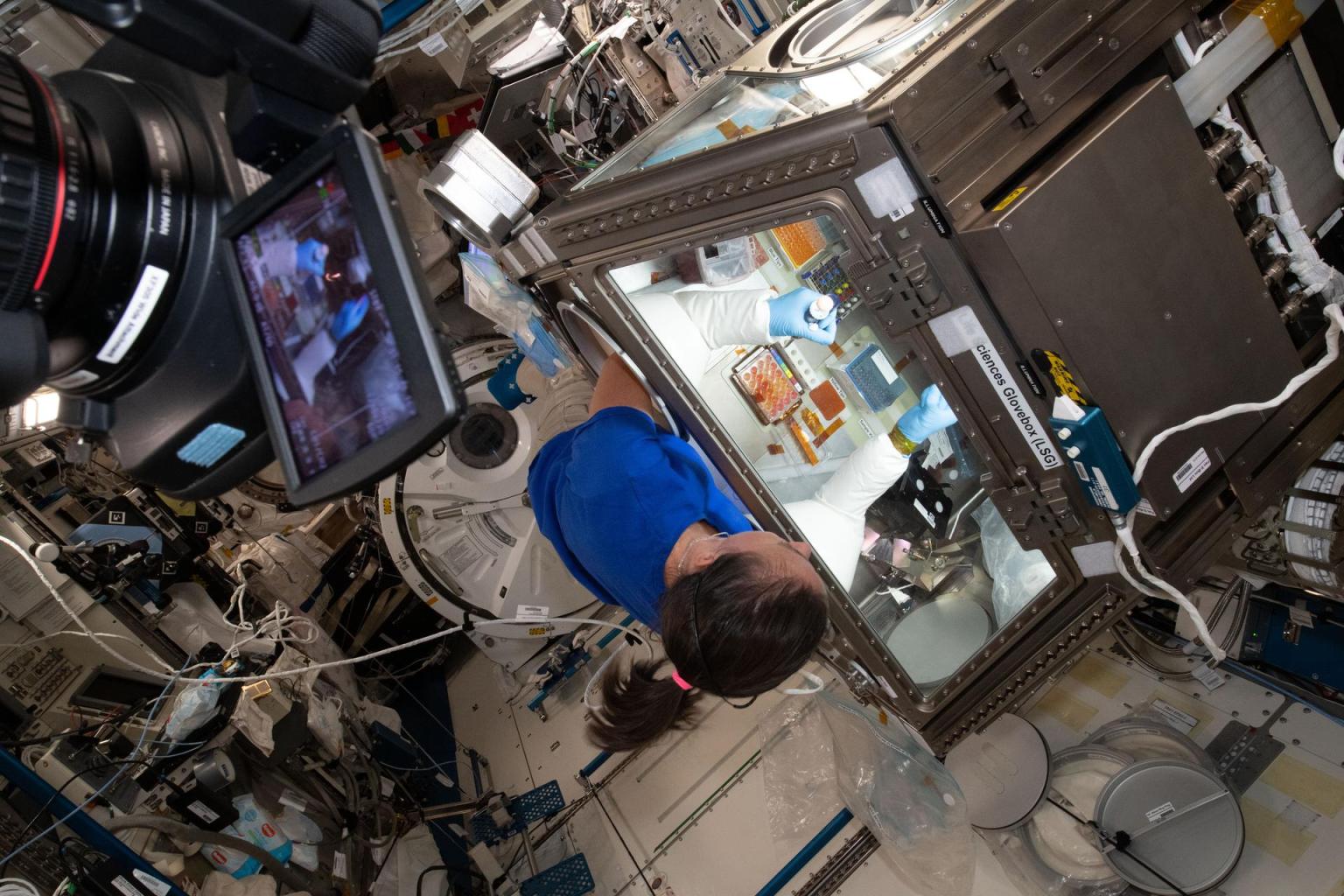
Melissa L. Gaskill
Microgravity, a unique orbit, crewed laboratory, twenty years and counting, adding subjects adds time.
The International Space Station provides unique features that enable innovative research, including microgravity, exposure to space, a unique orbit, and hands-on operation by crew members.
The space station provides consistent, long-term access to microgravity. Eliminating the effects of Earth’s gravity on experiments is a game-changer across many disciplines, including research on living things and physical and chemical processes. For example, without gravity hot air does not rise, so flames become spherical and behave differently. Removing the forces of surface tension and capillary movement allows scientists to examine fluid behavior more closely.

The speed, pattern, and altitude of the space station’s orbit provide unique advantages. Traveling at 17,500 miles per hour, it circles the planet every 90 minutes, passing over a majority of Earth’s landmass and population centers in daylight and darkness. Its 250-mile-high altitude is low enough for detailed observation of features, atmospheric phenomena, and natural disasters from different angles and with varying lighting conditions. At the same time, the station is high enough to study how space radiation affects material durability and how organisms adapt and examine phenomena such as neutron stars and blackholes. The spacecraft also places observing instruments outside Earth’s atmosphere and magnetic field, which can interfere with observations from the ground.

Other satellites in orbit contain scientific experiments and conduct Earth observations, but the space station also has crew members aboard to manage and maintain scientific activities. Human operators can respond to and assess events in real time, swap out experiment samples, troubleshoot, and observe results first-hand. Crew members also pack experiment samples and send them back to the ground for detailed analysis.
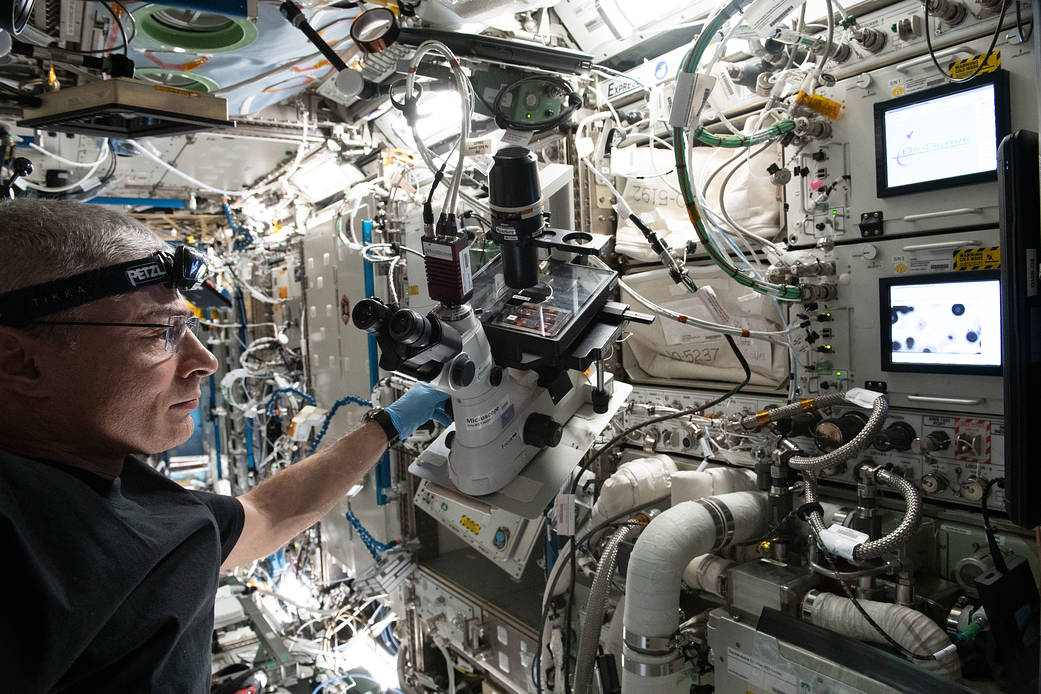
Thanks to the space station’s longevity, experiments can continue for months or even years. Scientists can design follow-up studies based on previous results, and every expedition offers the chance to expand the number of subjects for human research.
One area of long-term human research is on changes in vision, first observed when astronauts began spending months at a time in space. Scientists wondered whether fluids shifting from the lower to the upper body in microgravity caused increased pressure inside the head that changed eye shape. The Fluid Shifts investigation began in 2015 and continued to measure the extent of fluid shifts in multiple astronauts through 2020. 1
Whether the original study is long or short, it can take years for research to go from the lab into practical applications. Many steps are involved, some of them lengthy. First, researchers must come up with a question and a possible answer, or hypothesis. For example, Fluid Shifts questioned what was causing vision changes and a possible answer was increased fluid pressure in the head. Scientists must then design an experiment to test the hypothesis, determining what data to collect and how to do so.
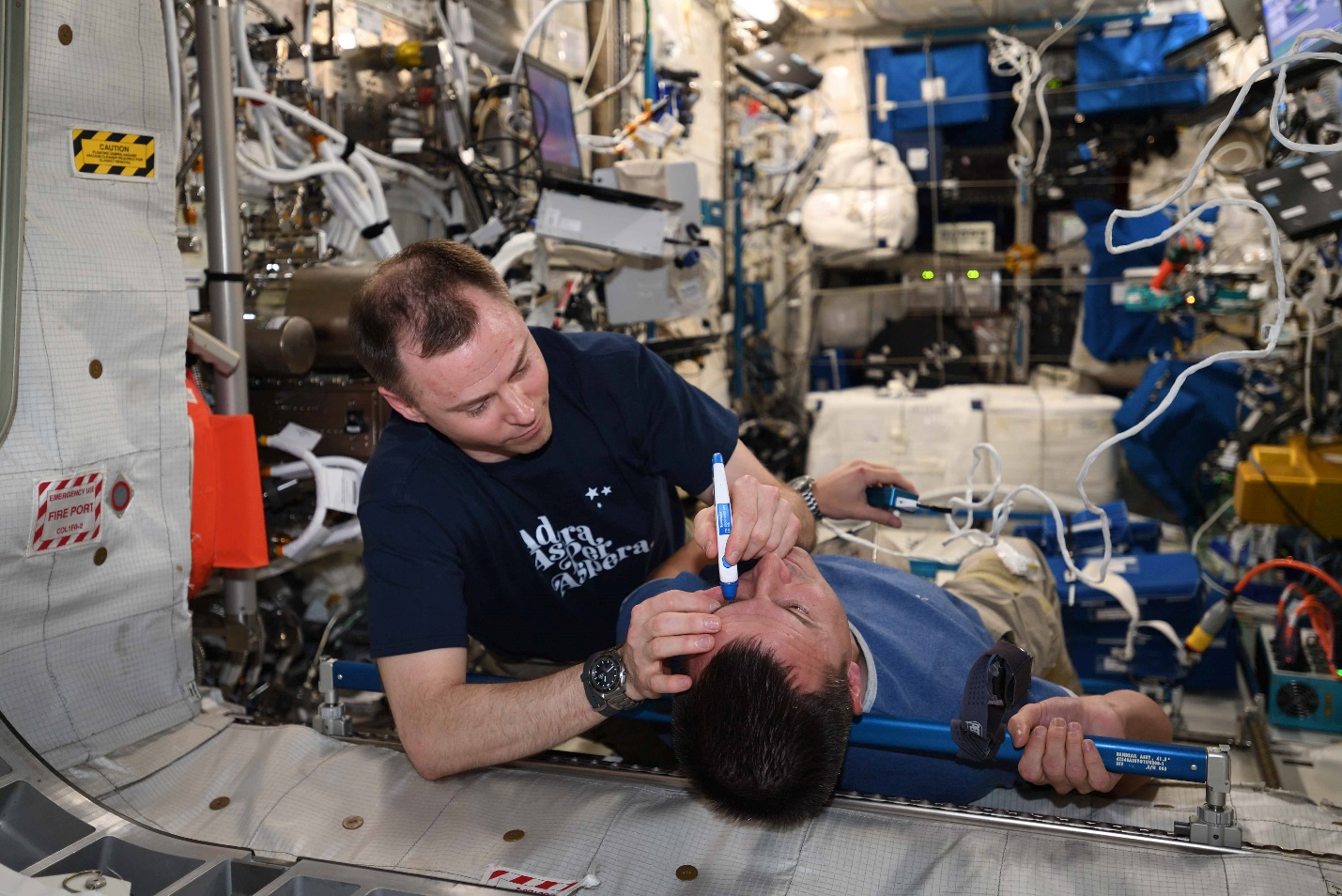
Getting research onto the space station in the first place takes time, too. NASA reviews proposals for scientific merit and relevance to the agency’s goals. Selected investigations are assigned to a mission, typically months in the future. NASA works with investigators to meet their science requirements, obtain approvals, schedule crew training, develop flight procedures, launch hardware and supplies, and collect any preflight data needed. Once the study launches, in-flight data collection begins. When scientists complete their data collection, they need time to analyze the data and determine what it means. This may take a year or more.
Scientists then write a paper about the results – which can take many months – and submit it to a scientific journal. Journals send the paper to other experts in the same field, a process known as peer review. According to one analysis, this review takes an average of 100 days. 2 The editors may request additional analysis and revisions based on this review before publishing.
Aspects of research on the space station can add more time to the process. Generally, the more test subjects, the better – from 100 to 1,000 subjects for statistically significant results for clinical research. But the space station typically only houses about six people at a time.
Lighting Effects shows how the need for more subjects adds time to a study. This investigation examined whether adjusting the intensity and color of lighting inside the station could help improve crew circadian rhythms, sleep, and cognitive performance. To collect data from enough crew members, the study ran from 2016 until 2020.
Other lengthy studies about how humans adapt to life in space include research on loss of heart muscle and a suite of long-term studies on nutrition, including producing fresh food in space.

For physical science studies, investigators can send batches of samples to the space station and collect data more quickly, but results can create a need for additional research. Burning and Suppression of Solids ( BASS ) examined the characteristics of a wide variety of fuel samples from 2011 to 2013, and BASS-II continued that work through 2017. The Saffire series of fire safety demonstrations began in 2016 and wrapped up in 2024. Researchers have answered many burning (pun intended) questions, but still have much to learn about preventing, detecting, and extinguishing fires in space.

The timeline for scientific results can run long, especially in microgravity. But those results can be well worth the wait.
Melissa Gaskill International Space Station Research Communications Team Johnson Space Center
Search this database of scientific experiments to learn more about those mentioned above.
1 Macias BR, Liu JHK, Grande-Gutierrez N, Hargens AR. Intraocular and intracranial pressures during head-down tilt with lower body negative pressure. Aerosp Med Hum Perform. 2015; 86(1):3–7. https://www.ingentaconnect.com/content/asma/amhp/2015/00000086/00000001/art00004;jsessionid=31bonpcj2e8tj.x-ic-live-01
2 Powell K. Does it take too long to publish research? Nature 530, pages148–151 (2016). https://www.nature.com/articles/530148a
Discover More Topics
Station Science 101
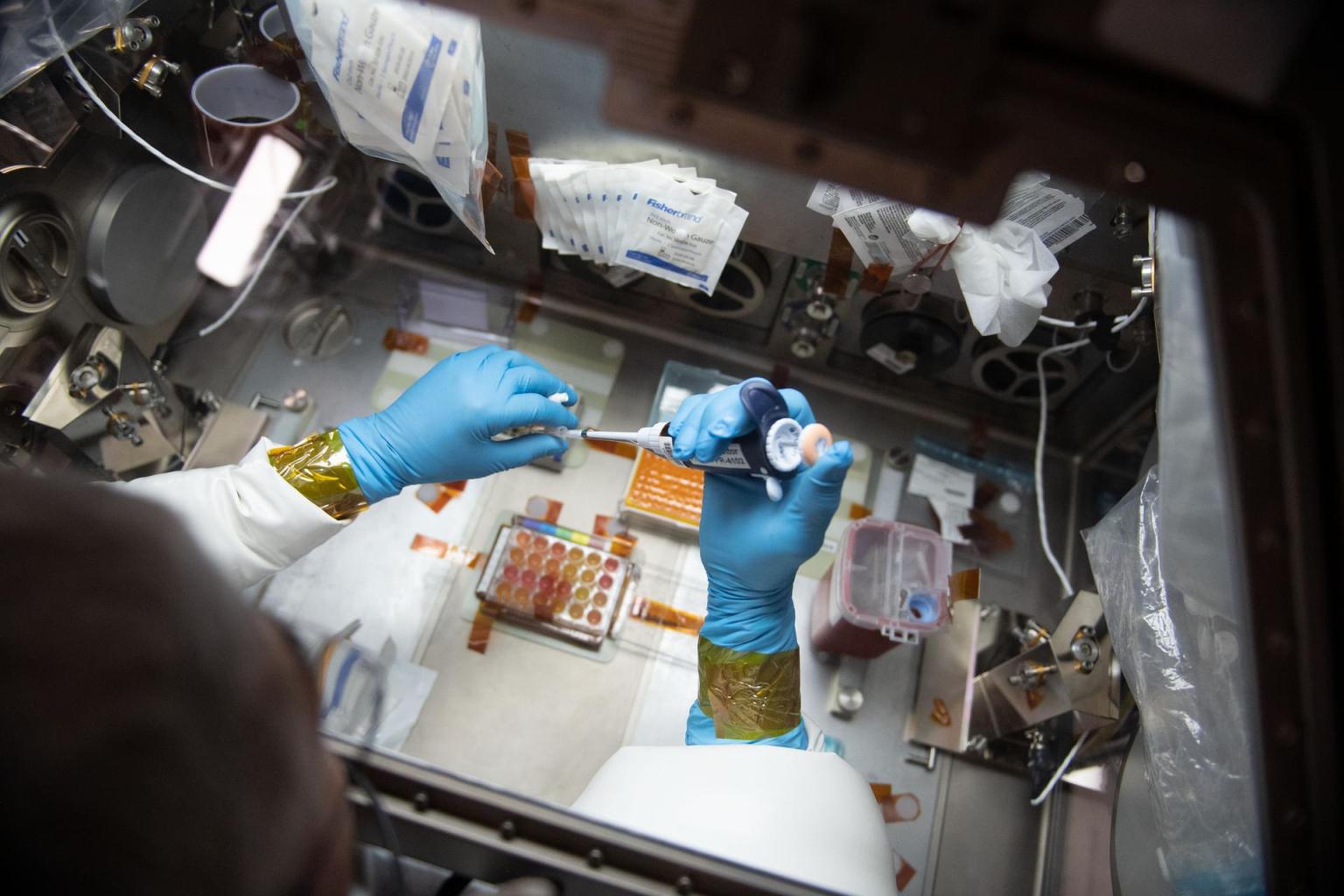
Latest News from Space Station Research

Space Station Research and Technology Resources

Station Benefits for Humanity

Related Terms
- ISS Research
- International Space Station (ISS)
- Johnson Space Center
Along with Stanford news and stories, show me:
- Student information
- Faculty/Staff information
We want to provide announcements, events, leadership messages and resources that are relevant to you. Your selection is stored in a browser cookie which you can remove at any time using “Clear all personalization” below.
Speaking, writing and reading are integral to everyday life, where language is the primary tool for expression and communication. Studying how people use language – what words and phrases they unconsciously choose and combine – can help us better understand ourselves and why we behave the way we do.
Linguistics scholars seek to determine what is unique and universal about the language we use, how it is acquired and the ways it changes over time. They consider language as a cultural, social and psychological phenomenon.
“Understanding why and how languages differ tells about the range of what is human,” said Dan Jurafsky , the Jackson Eli Reynolds Professor in Humanities and chair of the Department of Linguistics in the School of Humanities and Sciences at Stanford . “Discovering what’s universal about languages can help us understand the core of our humanity.”
The stories below represent some of the ways linguists have investigated many aspects of language, including its semantics and syntax, phonetics and phonology, and its social, psychological and computational aspects.
Understanding stereotypes
Stanford linguists and psychologists study how language is interpreted by people. Even the slightest differences in language use can correspond with biased beliefs of the speakers, according to research.
One study showed that a relatively harmless sentence, such as “girls are as good as boys at math,” can subtly perpetuate sexist stereotypes. Because of the statement’s grammatical structure, it implies that being good at math is more common or natural for boys than girls, the researchers said.
Language can play a big role in how we and others perceive the world, and linguists work to discover what words and phrases can influence us, unknowingly.
How well-meaning statements can spread stereotypes unintentionally
New Stanford research shows that sentences that frame one gender as the standard for the other can unintentionally perpetuate biases.
Algorithms reveal changes in stereotypes
New Stanford research shows that, over the past century, linguistic changes in gender and ethnic stereotypes correlated with major social movements and demographic changes in the U.S. Census data.
Exploring what an interruption is in conversation
Stanford doctoral candidate Katherine Hilton found that people perceive interruptions in conversation differently, and those perceptions differ depending on the listener’s own conversational style as well as gender.
Cops speak less respectfully to black community members
Professors Jennifer Eberhardt and Dan Jurafsky, along with other Stanford researchers, detected racial disparities in police officers’ speech after analyzing more than 100 hours of body camera footage from Oakland Police.
How other languages inform our own
People speak roughly 7,000 languages worldwide. Although there is a lot in common among languages, each one is unique, both in its structure and in the way it reflects the culture of the people who speak it.
Jurafsky said it’s important to study languages other than our own and how they develop over time because it can help scholars understand what lies at the foundation of humans’ unique way of communicating with one another.
“All this research can help us discover what it means to be human,” Jurafsky said.
Stanford PhD student documents indigenous language of Papua New Guinea
Fifth-year PhD student Kate Lindsey recently returned to the United States after a year of documenting an obscure language indigenous to the South Pacific nation.
Students explore Esperanto across Europe
In a research project spanning eight countries, two Stanford students search for Esperanto, a constructed language, against the backdrop of European populism.
Chris Manning: How computers are learning to understand language
A computer scientist discusses the evolution of computational linguistics and where it’s headed next.
Stanford research explores novel perspectives on the evolution of Spanish
Using digital tools and literature to explore the evolution of the Spanish language, Stanford researcher Cuauhtémoc García-García reveals a new historical perspective on linguistic changes in Latin America and Spain.
Language as a lens into behavior
Linguists analyze how certain speech patterns correspond to particular behaviors, including how language can impact people’s buying decisions or influence their social media use.
For example, in one research paper, a group of Stanford researchers examined the differences in how Republicans and Democrats express themselves online to better understand how a polarization of beliefs can occur on social media.
“We live in a very polarized time,” Jurafsky said. “Understanding what different groups of people say and why is the first step in determining how we can help bring people together.”
Analyzing the tweets of Republicans and Democrats
New research by Dora Demszky and colleagues examined how Republicans and Democrats express themselves online in an attempt to understand how polarization of beliefs occurs on social media.
Examining bilingual behavior of children at Texas preschool
A Stanford senior studied a group of bilingual children at a Spanish immersion preschool in Texas to understand how they distinguished between their two languages.
Predicting sales of online products from advertising language
Stanford linguist Dan Jurafsky and colleagues have found that products in Japan sell better if their advertising includes polite language and words that invoke cultural traditions or authority.
Language can help the elderly cope with the challenges of aging, says Stanford professor
By examining conversations of elderly Japanese women, linguist Yoshiko Matsumoto uncovers language techniques that help people move past traumatic events and regain a sense of normalcy.
Cornell Chronicle
- Architecture & Design
- Arts & Humanities
- Business, Economics & Entrepreneurship
- Computing & Information Sciences
- Energy, Environment & Sustainability
- Food & Agriculture
- Global Reach
- Health, Nutrition & Medicine
- Law, Government & Public Policy
- Life Sciences & Veterinary Medicine
- Physical Sciences & Engineering
- Social & Behavioral Sciences
- Coronavirus
- News & Events
- Public Engagement
- New York City
- Photos of the Week
- Big Red Sports
- Freedom of Expression
- Student Life
- University Statements
Around Cornell
- All Stories
- In the News
- Expert Quotes
- Cornellians

News directly from Cornell's colleges and centers
Research: Technology is changing how companies do business
By sarah mangus-sharpe.
A new study from the Cornell SC Johnson College of Business advances understanding of the U.S. production chain evolution amidst technological progress in information technology (IT), shedding light on the complex connections between business IT investments and organizational design. Advances in IT have sparked significant changes in how companies design their production processes. In the paper " Production Chain Organization in the Digital Age: Information Technology Use and Vertical Integration in U.S. Manufacturing ," which published April 30 in Management Science, Chris Forman , the Peter and Stephanie Nolan Professor in the Dyson School of Applied Economics and Management , and his co-author delved into what these changes mean for businesses and consumers.
Forman and Kristina McElheran, assistant professor of strategic management at University of Toronto, analyzed U.S. Census Bureau data of over 5,600 manufacturing plants to see how the production chains of businesses were affected by the internet revolution. Their use of census data allowed them to look inside the relationships among production units within and between companies and how transaction flows changed after companies invested in internet-enabled technology that facilitated coordination between them. The production units of many of the companies in their study concurrently sold to internal and external customers, a mix they refer to as plural selling. They found that the reduction in communication costs enabled by the internet shifted the mix toward more sales outside of the firm, or less vertical integration.
The research highlights the importance of staying ahead of the curve in technology. Companies that embrace digital technologies now are likely to be the ones that thrive in the future. And while there are still many unanswered questions about how these changes will play out, one thing is clear: The relationship between technology and business is only going to become more and more intertwined in the future.
Read the full story on the Cornell SC Johnson College of Business news site, BusinessFeed.
Media Contact
Media relations office.
Get Cornell news delivered right to your inbox.
You might also like

Gallery Heading

Transforming the understanding and treatment of mental illnesses.
Información en español
Celebrating 75 Years! Learn More >>
- Science News
- Meetings and Events
- Social Media
- Press Resources
- Email Updates
- Innovation Speaker Series
Basic Research Powers the First Medication for Postpartum Depression
May 14, 2024 • Feature Story • 75th Anniversary
At a Glance
- Postpartum depression (PPD) is a common mental disorder that many women experience after giving birth.
- Onset of PPD coincides with a dramatic drop in levels of a brain-derived steroid (neurosteroid) known as allopregnanolone.
- Decades of research supported by NIMH illuminated the role of neurosteroids like allopregnanolone in mental illnesses.
- In 2019, brexanolone—a medication that acts by mimicking allopregnanolone—became the first approved drug to treat PPD.
- Able to significantly and rapidly reduce PPD symptoms, brexanolone was a major leap forward in depression treatment.
Joshua A. Gordon, M.D., Ph.D., a practicing psychiatrist at the time, would never forget the call he received one night from a distraught mother.

“She was plagued with a deep, inescapable hopelessness—so depressed she was afraid she was going to hurt her month-old daughter. I helped her get to the hospital, where she spent the next 2 months in an in-patient program trying every available treatment to recover,” said Dr. Gordon, now the Director of the National Institute of Mental Health (NIMH).
Unfortunately, this experience is not uncommon among women and other postpartum people who may feel intense sadness, anxiety, and loss of interest after giving birth. These symptoms can be signs of a clinical disorder known as postpartum depression (PPD) . Unlike the "baby blues" or feelings of sadness many new mothers experience in the days after delivery, PPD is more intense and long-lasting, with damaging impacts on health and well-being.
More than the blues: Impacts of PPD on women's mental health
Depression is a common but serious mood disorder. According to the Centers for Disease Control and Prevention (CDC), rates of depression are high—and rising—among postpartum women. Using data from the 2018 Pregnancy Risk Assessment Monitoring System , the CDC found that about 1 in 8 postpartum women had symptoms of depression, while another CDC study showed rates of PPD that were seven times higher in 2015 compared to 2000.
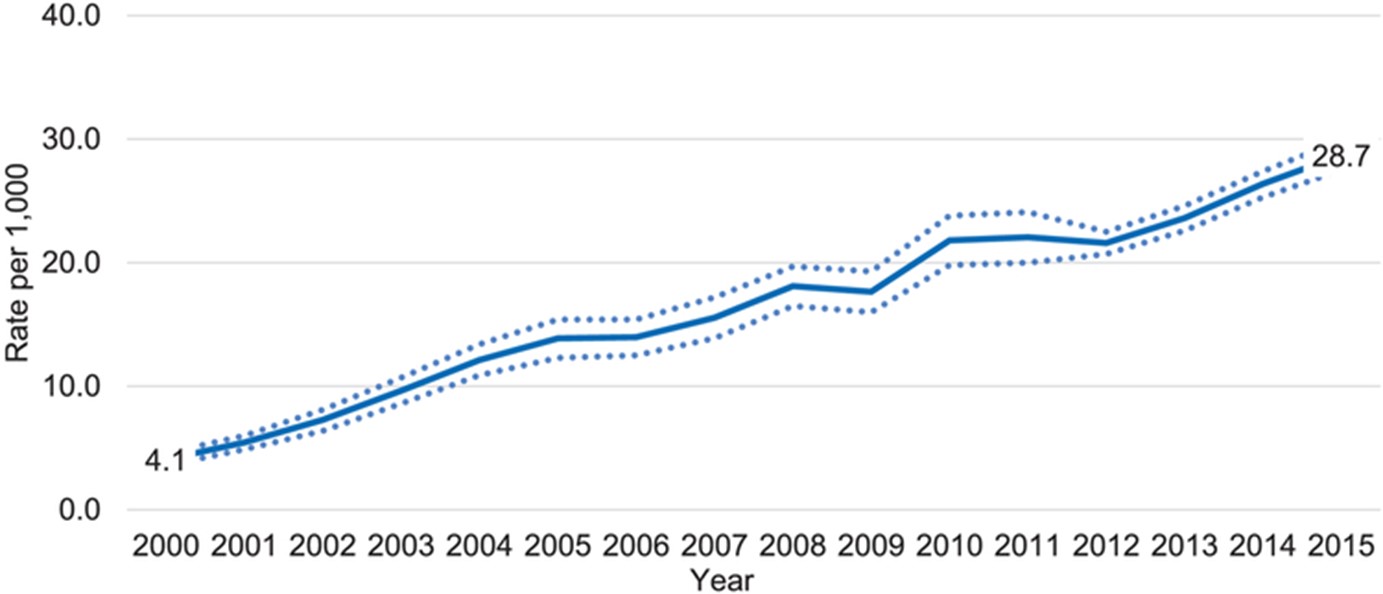
Depression can happen to anyone, and it's especially tough for new moms dealing with the physical challenges of childbirth and the stresses of caring for a young child. When women experience PPD, they often have strong feelings of sadness, anxiety, worthlessness, and guilt. Their sleep, eating, thoughts, and actions can all change noticeably. These mood and behavior changes can be highly distressing and even life-threatening, making it difficult for a woman to do everyday things and take care of herself or her child. In extreme cases, women with PPD may be at risk of hurting themselves or their child or attempting suicide.
Fast-acting, effective treatment for PPD can be life-changing and potentially lifesaving. However, for too long, such care was hard to reach, leaving many women to struggle with depression at a pivotal point in life. Despite some similarities, PPD is not the same as major depression at other times in life. Because of this, usual depression treatments are much less effective in managing the symptoms of PPD.

“PPD is very difficult to treat,” said Mi Hillefors, M.D., Ph.D., Deputy Director of the NIMH Division of Translational Research. “It is usually treated with medications originally approved for major depression—despite limited evidence that they are effective in treating PPD. Standard depression treatments, including antidepressants, psychotherapy, and brain stimulation therapy, can also take weeks or longer to work.”
PPD’s unique risk factors reflect the physical changes of pregnancy and the postpartum period, which include dramatic changes in levels of many hormones and other molecules.
These biological changes had long been seen as a possible source of postpartum mood disorders like depression. But could they also be a solution?
Unlocking the power of allopregnanolone through basic research
Some psychiatric medications owe their discovery to chance. Not so with brexanolone, the first-ever medication to specifically treat PPD. Brexanolone culminated a long series of research studies, much of it funded by NIMH as part of its commitment to understand and support women’s mental health .
Thanks to NIMH-supported basic research, brexanolone was developed by design—a design centered around a molecule called allopregnanolone .
Allopregnanolone is a steroid naturally produced in the brain and with important actions there, such as regulating neurotransmitter activity and protecting neurons from damage. Its impact extends to mental health, with higher levels linked to better mood, lower anxiety, and reduced depression .

Allopregnanolone is also important to pregnancy , during which its levels are extremely high. This happens because of the enhanced production of a hormone called progesterone, which prepares the body for pregnancy and childbirth.
In the last few months of pregnancy, the ovaries and placenta make more progesterone, causing a huge rise in allopregnanolone levels. These levels then drop rapidly after birth. Because allopregnanolone plays a crucial role in mood, these ups and downs can impact a woman’s mental health during and after pregnancy.
Researchers had been aware of brain-derived steroids like allopregnanolone as far back as the 1940s. But the journey to a new PPD treatment began within NIMH's Intramural Research Program (IRP) . At the helm was the NIMH Scientific Director at that time, Steven Paul, M.D., who collaborated with researchers in the NIMH Clinical Neuroscience Branch and at other NIH institutes, including the National Institute of Neurological Disorders and Stroke (NINDS). The researchers sought to understand how the steroids work, change over time, respond to stress, and ultimately relate to health and disease.
Early discoveries came in the 1980s. Paul, working with Maria Majewska, Ph.D., Jacqueline Crawley, Ph.D., A. Leslie Morrow, Ph.D., and other researchers showed that hormones such as progesterone and molecules derived from them have calming and anxiety-reducing effects . Extensive research by Paul’s lab showed that these anxiolytic effects come from enhancing the activity of GABA by binding to specific sites on its receptor. As the main inhibitory neurotransmitter (chemical messenger), GABA reduces the activity of neurons, making them less likely to fire. When molecules bind to its receptor, GABA becomes more potent at inhibiting electrical activity in the brain, with calming effects on behavior.
Paul and IRP colleague Robert Purdy, Ph.D., used the term “ neuroactive steroids ,” or neurosteroids, to describe these molecules able to bind to receptors in the brain to rapidly alter neuronal excitability. Their work in animals confirmed that allopregnanolone is synthesized in the brain . They also showed the effects of allopregnanolone on GABA receptors in humans. Moreover, they found that allopregnanolone affects the response to stress , with acute stress leading the neurosteroid to increase to levels that alter GABA activity. These findings suggested that neurosteroids play an important role in helping animals “reset” and adaptively respond to stressful life events.
Together, this IRP-conducted research established the importance of neurosteroids via their presence in the brain, ability to reduce neuronal activity, and release during stress. Although much of this work was conducted in animals, it would spotlight neurosteroids—and allopregnanolone in particular—as promising targets for treating mental disorders, eventually opening the door to their therapeutic use in humans.
Bridging the gap to advance clinical intervention
While NIMH intramural researchers were making remarkable strides, researchers at other institutions were also conducting work bolstered by funding from NIMH. Among them were Alessandro Guidotti, M.D., at the University of Illinois at Chicago; Istvan Mody, Ph.D., at the University of California, Los Angeles; and Charles Zorumski, M.D., at Washington University in St. Louis. Their NIMH-funded research propelled understanding of inhibitory neurosteroids and their importance in reducing the adverse effects of stress. This work would be the impetus for homing in on allopregnanolone as a treatment for PPD.

Guidotti and colleagues conducted several NIMH-funded studies. Their research in rodents confirmed that allopregnanolone is produced in the brain and helps regulate neuronal excitability by acting on GABA receptors. They also built on the knowledge that neurosteroids are affected by stress. However, unlike acute stress, a stressor lasting multiple weeks led to a decrease in allopregnanolone in brain areas involved in anxiety- and depression-like behaviors.
Importantly, their NIMH-funded work offered some of the earliest evidence that allopregnanolone contributes to depression by showing significantly lower levels in people with depression compared to people without the disorder, a rise in levels (but not that of other neurosteroids) after treatment with antidepressant medication , and a link between increased levels and reduced depression symptoms .
NIMH and NINDS funded multiple studies by Mody and colleagues on interactions of neurosteroids, stress, and GABA receptors. This research was integral to understanding a mechanism in the brains of mice that might explain why some people become depressed after childbirth. Their NIMH-supported research showed changes in GABA receptors in the brain, where neurosteroids are active, that impaired the body’s ability to adapt to hormonal fluctuations. Animals with an irregular GABA receptor component lacking sensitivity to neurosteroids showed depression-like behaviors and reduced maternal care; treating them with a drug that restored the receptor’s function reversed those changes.
Another study by Mody and colleagues revealed changes in GABA expression during pregnancy that led to greater neuronal activity in the brain—but could be brought down by allopregnanolone. This finding opened the door to future studies exploring whether a postpartum drop in the neurosteroid contributed to the risk for mood disorders after birth.
Zorumski led a team in extensively studying neurosteroids as well. Among their seminal findings was identifying the mechanisms by which inhibitory neurosteroids like allopregnanolone affect GABA receptor activity . Their NIMH-funded work dramatically augmented knowledge of how neurosteroids alter GABA receptors to contribute to the risk for mental disorders like PPD.
“The accumulated evidence from these studies established the necessary bridges to justify examining a potential therapeutic role for allopregnanolone in women with PPD,” said Peter Schmidt, M.D., Chief of the NIMH Behavioral Endocrinology Branch.
By the 2010s, researchers had a much better understanding of how allopregnanolone is linked to PPD. Studies showed decreased allopregnanolone in pregnant and postpartum women with symptoms of depression and higher allopregnanolone associated with a lower risk of PPD . The possibility that PPD might be caused by the downregulation of GABA receptors in response to low levels of allopregnanolone after birth inspired researchers to put that theory to the test in clinical studies with human participants.
Taking allopregnanolone from bench to bedside
Extensive research, supported by NIMH and other NIH institutes, found that neurosteroids play a key role in how people deal with stress. They also contribute to the development of mood disorders like anxiety and depression. For allopregnanolone, evidence that it sharply decreases after pregnancy and regulates GABA activity gave rise to the notion that it contributes to PPD—and inspired hope it could be used to treat the disorder.
The biopharmaceutical company Sage Therapeutics utilized this basic research to develop brexanolone. Administered intravenously by a health care professional in a doctor’s office or clinic, brexanolone mimics the effects of allopregnanolone, increasing the inhibitory actions of GABA receptors.
Stephen Kanes, M.D., Ph.D., at Sage Therapeutics and Samantha Meltzer-Brody, M.D., MPH, at the University of North Carolina led several randomized clinical trials to measure the effectiveness of the medication in treating PPD and evaluate its safety and tolerability. The studies, which recruited adult women with PPD from hospitals, research centers, and psychiatric clinics across the United States, measured the effects of brexanolone compared to a placebo over 4 weeks.
The trials were a success. Brexanolone significantly and meaningfully reduced PPD symptoms , and it had only mild side effects. Compared to usual depression treatments, brexanolone brought about a faster response and greater improvement . Whereas most antidepressants take weeks to work, brexanolone improved symptoms and functioning in women with PPD within a few hours to days. And the effects lasted up to a month after the treatment stopped. Not only was brexanolone more effective, but it also worked faster than other depression medications.
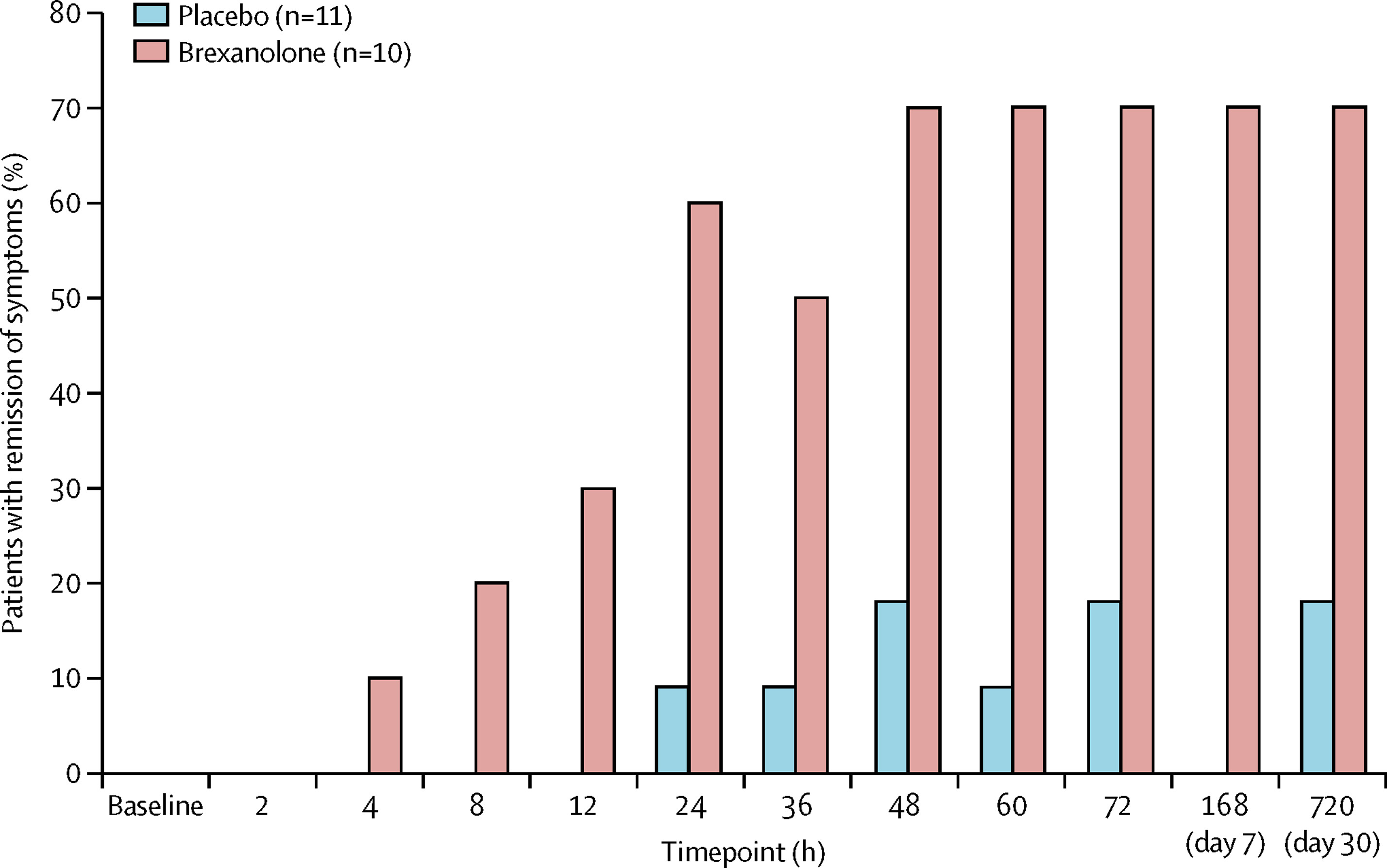
“The dramatic impact of basic research on real-world health outcomes has been inspiring. The fact that NIMH-supported studies contributed to successful drug development in a matter of decades is a remarkable feat and a powerful demonstration of the potential of this foundational research,” said Dr. Gordon.
Based on this promising evidence, the U.S. Food and Drug Administration (FDA) gave brexanolone priority review and breakthrough therapy designation in September 2016. Then, in March 2019, the FDA approved brexanolone , making it the first drug to treat PPD.
Brightening the future for women with PPD
For women with PPD, brexanolone was a long-awaited reason to celebrate. For NIMH, it was a testament to discoveries made through the decades of research it supported. Although some barriers to treatment persisted, women now had greater hope for treating depression symptoms after pregnancy.
“The approval of brexanolone was an important milestone. Finally, an effective, fast-acting medication specifically to treat PPD,” said Dr. Hillefors. “It was also a victory for psychiatric neuroscience because basic and translational research—by design, not chance—led to a truly novel and effective treatment for a psychiatric disorder.”
Without NIMH-supported studies providing the foundational knowledge of neurosteroids, researchers may have never made the connection between allopregnanolone and treating PPD. “That’s why the approval of brexanolone is such a cause for celebration for mental health research: It represents a true bench-to-bedside success,” said Dr. Gordon.
The success of brexanolone has continued to open the door to exciting advancements in mental health care. For instance, researchers and clinicians are investigating ways to make brexanolone work better for all postpartum people. Researchers are also testing how neurosteroids can be used to treat other forms of depression and other mental health conditions.
Just the beginning of treatment advances for PPD
Brexanolone is only the start of what will hopefully be a new future for PPD treatment. In August 2023, the FDA approved zuranolone as the first oral medication for PPD. Zuranolone acts via similar biological mechanisms as brexanolone. Its approval reflects the next step in NIMH-supported basic research being translated into clinical practice with real-world benefits.
The success of the drug, which is taken in pill form, was shown in two randomized multicenter clinical trials . Women with severe PPD who received zuranolone showed statistically significant and clinically meaningful improvements in depression symptoms compared to women who received a placebo. These effects were rapid, sustained through 45 days, and seen across a range of clinical measures. The benefits were mirrored in patients’ self-assessment of their depression symptoms.
According to Dr. Schmidt, “The approval of zuranolone to treat PPD provides women with a rapid and effective treatment that avoids some of the limitations of the original intravenous medication.”
And the journey is far from over. Researchers, clinicians, and industry are continuing to innovate new treatments for PPD to increase access and availability to ensure all people can receive help for their postpartum symptoms.
“While I will never forget that phone call from my patient, the development of these effective medications brings us hope for helping people with PPD and for the overall impact of basic research to truly make a difference in people’s lives,” concluded Dr. Gordon.
Publications
Burval, J., Kerns, R., & Reed, K. (2020). Treating postpartum depression with brexanolone. Nursing , 50 (5), 48−53. https://doi.org/10.1097/01.NURSE.0000657072.85990.5a
Cornett, E. M., Rando, L., Labbé, A. M., Perkins, W., Kaye, A. M., Kaye, A. D., Viswanath, O., & Urits, I. (2021). Brexanolone to treat postpartum depression in adult women. Psychopharmacology Bulletin , 51 (2), 115–130. https://www.ncbi.nlm.nih.gov/pmc/articles/PMC8146562/pdf/PB-51-2-115.pdf
Deligiannidis, K. M., Meltzer-Brody, S., Maximos, B., Peeper, E. Q., Freeman, M., Lasser, R., Bullock, A., Kotecha, M., Li, S., Forrestal, F., Rana, N., Garcia, M., Leclair, B., & Doherty, J. (2023). Zuranolone for the treatment of postpartum depression. American Journal of Psychiatry , 180 (9), 668−675. https://doi.org/10.1176/appi.ajp.20220785
Deligiannidis, K. M., Kroll-Desrosiers, A. R., Mo, S., Nguyen, H. P., Svenson, A., Jaitly, N., ... & Shaffer, S. A. (2016). Peripartum neuroactive steroid and γ-aminobutyric acid profiles in women at-risk for postpartum depression. Psychoneuroendocrinology , 70 , 98−107. https://doi.org/10.1016/j.psyneuen.2016.05.010
Edinoff, A. N., Odisho, A. S., Lewis, K., Kaskas, A., Hunt, G., Cornett, E. M., Kaye, A. D., Kaye, A., Morgan, J., Barrilleaux, P. S., Lewis, D., Viswanath, O., & Urits, I. (2021). Brexanolone, a GABAA modulator, in the treatment of postpartum depression in adults: A comprehensive review. Frontiers in Psychiatry , 12 , Article 699740. https://doi.org/10.3389/fpsyt.2021.699740
Epperson, C. N., Rubinow, D. R., Meltzer-Brody, S., Deligiannidis, K. M., Riesenberg, R., Krystal, A.D., Bankole, K., Huang, M. Y., Li, H., Brown, C., Kanes, S. J., & Lasser R. (2023). Effect of brexanolone on depressive symptoms, anxiety, and insomnia in women with postpartum depression: Pooled analyses from 3 double-blind, randomized, placebo-controlled clinical trials in the HUMMINGBIRD clinical program. Journal of Affective Disorders , 320 , 353−359. https://doi.org/10.1016/j.jad.2022.09.143
Gilbert Evans, S. E., Ross, L. E., Sellers, E. M., Purdy, R. H., & Romach, M. K. (2005). 3α-reduced neuroactive steroids and their precursors during pregnancy and the postpartum period. Gynecological Endocrinology , 21 (5), 268−279. https://doi.org/10.1080/09513590500361747
Guintivano, J., Manuck, T., & Meltzer-Brody, S. (2018). Predictors of postpartum depression: A comprehensive review of the last decade of evidence. Clinical Obstetrics and Gynecology , 61 (3), 591−603. https://doi.org/10.1097/GRF.0000000000000368
Gunduz-Bruce, H., Koji, K., & Huang, M.-Y. (2022). Development of neuroactive steroids for the treatment of postpartum depression. Journal of Neuroendocrinology , 34 (2), Article e13019. https://doi.org/10.1111/jne.13019
Haight, S. C., Byatt, N., Moore Simas, T. A., Robbins, C. L., & Ko, J. Y. (2019). Recorded diagnoses of depression during delivery hospitalizations in the United States, 2000-2015. Obstetrics and Gynecology , 133 (6), 1216−1223. https://doi.org/10.1097/AOG.0000000000003291
Hellgren, C., Åkerud, H., Skalkidou, A., Bäckström, T., & Sundström-Poromaa, I. (2014). Low serum allopregnanolone is associated with symptoms of depression in late pregnancy. Neuropsychobiology , 69 (3), 147–153. https://doi.org/10.1159/000358838
Hutcherson, T. C., Cieri-Hutcherson, N. E., & Gosciak, M. F. (2023). Brexanolone for postpartum depression. American Journal of Health-System Pharmacy , 77 (5), 336−345. https://doi.org/10.1093/ajhp/zxz333
Kanes, S., Colquhoun, H., Gunduz-Bruce, H., Raines, S., Arnold, R., Schacterle, A., Doherty, J., Epperson, C. N., Deligiannidis, K. M., Riesenberg, R., Hoffmann, E., Rubinow, D., Jonas, J., Paul, S., & Meltzer-Brody, S. (2017). Brexanolone (SAGE-547 injection) in post-partum depression: A randomised controlled trial. The Lancet , 390(10093), 480−489. https://doi.org/10.1016/S0140-6736(17)31264-3
Leader, L. D., O'Connell, M., & VandenBerg, A. (2019). Brexanolone for postpartum depression: Clinical evidence and practical considerations. Pharmacotherapy , 39 (11), 1105–1112. https://doi.org/10.1002/phar.2331
Maguire, J., & Mody, I. (2008). GABAAR plasticity during pregnancy: Relevance to postpartum depression. Neuron , 59 (2), P207–P213. https://doi.org/10.1016/j.neuron.2008.06.019
Maguire, J., & Mody, I. (2016). Behavioral deficits in juveniles mediated by maternal stress hormones in mice. Neural Plasticity , Article 2762518. https://doi.org/10.1155/2016/2762518
Majewska, M. D., Harrison, N. L., Schwartz, R. D., Barker, J. L., & Paul, S. M. (1986). Steroid hormone metabolites are barbiturate-like modulators of the GABA receptor. Science , 232 (4753), 1004−1007. https://doi.org/10.1126/science.2422758
McEvoy, K., & Osborne, L. M. (2019). Allopregnanolone and reproductive psychiatry: An overview. International Review of Psychiatry , 31 (3), 237–244. https://doi.org/10.1080/09540261.2018.1553775
Meltzer-Brody, S., Colquhoun, H., Riesenberg, R., Epperson, C. N., Deligiannidis, K. M., Rubinow, D. R., Li, H., Sankoh, A. J., Clemson, C., Schacterle, A., Jonas, J., & Kanes, S. (2018). Brexanolone injection in post-partum depression: Two multicentre, double-blind, randomised, placebo-controlled, phase 3 trials. The Lancet , 392 (10152), 1058−1070. https://doi.org/10.1016/S0140-6736(18)31551-4
Morrison, K. E., Cole, A. B., Thompson, S. M., & Bale, T. L. (2019). Brexanolone for the treatment of patients with postpartum depression. Drugs Today , 55 (9), 537–544. https://doi.org/10.1358/dot.2019.55.9.3040864
Purdy, R. H., Morrow, A. L., Moore, P. H., & Paul, S. M. (1991). Stress-induced elevations of gamma-aminobutyric acid type A receptor-active steroids in the rat brain. Proceedings of the National Academy of Sciences , 88 (10), 4553−4557. https://doi.org/10.1073/pnas.88.10.4553
Scarff, J. R. (2019). Use of brexanolone for postpartum depression. Innovations in Clinical Neuroscience , 16 (11−12), 32–35.
Schüle, C., Nothdurfter, C., & Rupprecht, R. (2014). The role of allopregnanolone in depression and anxiety. Progress in Neurobiology , 113 , 79−87. https://doi.org/10.1016/j.pneurobio.2013.09.003
Selye, H. (1941). Anesthetic effect of steroid hormones. Experimental Biology and Medicine , 46 (1), 116–121. https://doi.org/10.3181/00379727-46-11907
Shorey, S., Chee, C. Y. I., Ng, E. D., Chan, Y. H., Tam, W. W. S., & Chong, Y. S. (2018). Prevalence and incidence of postpartum depression among healthy mothers: A systematic review and meta-analysis. Journal of Psychiatric Research , 104 , 235–248. https://doi.org/10.1016/j.jpsychires.2018.08.001
Slomian, J., Honvo, G., Emonts, P., Reginster, J. Y., & Bruyère, O. (2019). Consequences of maternal postpartum depression: A systematic review of maternal and infant outcomes. Women's Health , 15 , 1−55. https://doi.org/10.1177/1745506519844044
- Perinatal Depression (NIMH brochure)
- Depression in Women: 4 Things You Should Know (NIMH health topic page)
- Depression (NIMH health topic page)
- Major Depression (NIMH statistics page)
- Women and Mental Health (NIMH health topic page)
- A Bench-to-Bedside Story: The Development of a Treatment for Postpartum Depression (NIMH Director’s Message)
- Bench-to-Bedside: NIMH Research Leading to Brexanolone, First-Ever Drug Specifically for Postpartum Depression (NIIMH press release)
- Population Study Finds Depression Is Different Before, During, and After Pregnancy (NIMH research highlight)
- FDA Approves First Treatment for Post-Partum Depression (FDA news release)
- FDA Approves First Oral Treatment for Postpartum Depression (FDA news release)
Thank you for visiting nature.com. You are using a browser version with limited support for CSS. To obtain the best experience, we recommend you use a more up to date browser (or turn off compatibility mode in Internet Explorer). In the meantime, to ensure continued support, we are displaying the site without styles and JavaScript.
- View all journals
- Explore content
- About the journal
- Publish with us
- Sign up for alerts
- Published: 19 April 2022
Focus Issue: The Future Of Cancer Research
Nature Medicine volume 28 , page 601 ( 2022 ) Cite this article
14k Accesses
5 Citations
9 Altmetric
Metrics details
New treatments and technologies offer exciting prospects for cancer research and care, but their global impact rests on widespread implementation and accessibility.
Cancer care has advanced at an impressive pace in recent years. New insights into tumor immunology and biology, combined with advances in artificial intelligence, nano tools, genetic engineering and sequencing — to name but a few — promise ever-more-powerful capabilities in the prevention, diagnosis and personalized treatment of cancer. How do we harness and build on these advances? How do we make them work in different global settings? In this issue, we present a Focus dedicated to the future of cancer research, in which we take stock of progress and explore ways to deliver research and care that is innovative, sustainable and patient focused.
This year brought news that two of the first patients with leukemia to receive chimeric antigen receptor (CAR) T cell treatment remain in remission more than a decade later . Writing in this issue, Carl June — who helped to treat these first patients — and colleagues reflect on how early transplant medicine laid a solid foundation for CAR T cell development in blood cancers, and how this is now paving the way for the use of engineered cell therapies in solid cancers. In a noteworthy step toward this goal, Haas and colleagues present results of a phase 1 trial of CAR T cells in metastatic, castration-resistant prostate cancer — a disease that has seen relatively few new treatment options in recent years.
Up to now, CAR T cells have been used only in the context of relapsed or refractory hematological malignancies, but in this issue, Neelapu et al . present phase 2 study data that suggest CAR T cell therapy could be beneficial when used earlier in certain high-risk patients. In addition, prospective data from van den Brink et al . support a role for the gut microbiome composition in CAR T cell therapy outcomes, highlighting new avenues of research to help maximize therapeutic benefit.
Although the idea that the gut microbiome influences CAR T cell therapy outcomes may be relatively new, it has been known for some time that it has a role in the response to checkpoint-inhibitor immunotherapy. A plethora of microbe-targeting therapies are now under investigation for cancer treatment; in this issue, Pal and colleagues describe one such strategy — whereby the combination of a defined microbial supplement with checkpoint blockade led to improved responses in patients with advanced kidney cancer. In their Review, Jennifer Wargo and colleagues take stock of the latest research in this field, and predict that microbial targeting could become a pillar of personalized cancer care over the next decade.
The theme for this year’s World Cancer Day was ‘Close the care gap’ — a message that is woven through several pieces in this issue. Early detection strategies have enormous potential to make a difference in this area; reviewing the latest advances, Rebecca Fitzgerald and colleagues ask who should be tested, and how — and outline their vision for personalized, risk-based screening, keeping in mind practicality and clinical implementation. Journalist Carrie Arnold reports on an emerging strategy known as ‘theranostics’ that aims to both diagnose and treat cancers in a unified approach, highlighting the growing commercial interest in this field. Of course, commercial interest does not equate to widespread availability or equal access to new therapies, and increasingly sophisticated technologies — although beneficial for some — can serve to widen existing inequalities.
Pediatric cancers lag far behind adult cancers in terms of drug development and approval. Nancy Goodman, a patient advocate whose son died from a childhood cancer, argues that market failures are largely to blame for the gap — but that legislative changes can correct this. Although in some cases there is a strong mechanistic rationale for testing promising adult cancer therapies or combinations in children, translational research is also needed to identify new therapeutic targets — such as the approach taken by Behjati and colleagues , which sheds new light on the molecular characteristics of an aggressive form of infant leukemia.
Meanwhile, for adult cancers, countless new therapeutic modalities are on the horizon , and drug approvals based on genomic biomarkers have accelerated in recent years. Unfortunately, their implementation into routine clinical care is progressing at a much slower pace. In their Perspective, Emile Voest and colleagues point out that bridging this gap will require investment in health infrastructure, as well as in education and decision-support tools, among other things.
Perhaps the most striking gap is that between high-income countries and low- and middle-income countries, not only in terms of cancer survival outcomes but also in terms of resources and infrastructure for impactful research. In their Perspective, CS Pramesh and colleagues outline their top priorities for cancer research in low- and middle-income countries, arguing that cancer research must be regionally relevant and geared toward reducing the number of patients diagnosed with advanced disease. Practicality is key — a sentiment echoed by Bishal Gyawali and Christopher Booth, who call for a “ common sense revolution ” in oncology, and regulatory policies and trial designs that serve patients better.
To realize this goal, clinical trial endpoints and outcome measures should be designed to minimize the burden on patients and maximize the potential for improving on the standard of care. This should go beyond survival outcomes; systemic effects, including cachexia and pain, have a major impact on quality of life and mental health during and after treatment. Two articles in this issue highlight the enormous psychological burden associated with a cancer diagnosis; increased risks of depression, self-harm and suicide emphasize the need for psychosocial interventions and a holistic approach to treatment.
As noted by members of the Bloomberg New Economy International Cancer Coalition in their Comment , the widespread adoption of telemedicine and remote monitoring in response to the COVID-19 pandemic could, if retained, help to make cancer trials more patient centered. Therefore, as health systems and research infrastructures adapt to the ongoing pandemic, there exists an unprecedented opportunity to reshape the landscape of cancer research.
We at Nature Medicine are committed to helping shape this transformation. We are issuing a call for research papers that utilize innovative approaches to address current challenges in cancer prevention, detection, diagnosis and treatment — both clinical trials and population-based studies with global implications. Readers can find more information about publishing clinical research in Nature Medicine at https://www.nature.com/nm/clinicalresearch .
Rights and permissions
Reprints and permissions
About this article
Cite this article.
Focus Issue: The Future Of Cancer Research. Nat Med 28 , 601 (2022). https://doi.org/10.1038/s41591-022-01809-z
Download citation
Published : 19 April 2022
Issue Date : April 2022
DOI : https://doi.org/10.1038/s41591-022-01809-z
Share this article
Anyone you share the following link with will be able to read this content:
Sorry, a shareable link is not currently available for this article.
Provided by the Springer Nature SharedIt content-sharing initiative
Quick links
- Explore articles by subject
- Guide to authors
- Editorial policies
Sign up for the Nature Briefing newsletter — what matters in science, free to your inbox daily.
- Better Business Chronicles
- Operations Technology and Information Management
- Research With Impact
Research: Technology Is Changing How Companies Do Business

In the fast-paced world of modern business, technology plays a crucial role in shaping how companies operate. One area where this impact is particularly significant is in the organization of production chains—specifically the way goods are made and distributed.
A new study from the Cornell SC Johnson College of Business advances understanding of the U.S. production chain evolution amidst technological progress in information technology (IT), shedding light on the complex connections between business IT investments and organizational design.
Advances in IT have sparked significant changes in how companies design their production processes. In the paper “ Production Chain Organization in the Digital Age: Information Technology Use and Vertical Integration in U.S. Manufacturing ,” which published April 30 in Management Science, Chris Forman, the Peter and Stephanie Nolan Professor in the Dyson School of Applied Economics and Management, and his co-author delved into what these changes mean for businesses and consumers.
In running a manufacturing plant, a key decision is how much of the production process is handled in-house and how much is outsourced to other companies. This decision, known as vertical integration, can have big implications for a business. Advances in information and communication technology, such as those brought about by the internet, shifted the network of production flows for many firms.
Forman and Kristina McElheran, assistant professor of strategic management at University of Toronto, analyzed U.S. Census Bureau data of over 5,600 manufacturing plants to see how the production chains of businesses were affected by the internet revolution. Their use of census data allowed them to look inside the relationships among production units within and between companies and how transaction flows changed after companies invested in internet-enabled technology that facilitated coordination between them. The production units of many of the companies in their study concurrently sold to internal and external customers, a mix they refer to as plural selling. They found that the reduction in communication costs enabled by the internet shifted the mix toward more sales outside of the firm, or less vertical integration.
“The internet has made it cheaper and faster for companies to communicate and share information with each other. This means they can work together more efficiently without the need for as much vertical integration,” said Forman.
While some might worry that relying on external partners could make businesses more vulnerable, the research suggests otherwise. In fact, companies that were already using a plural governance approach before the internet age seem to be the most adaptable to these changes. Production units that were capacity-constrained were also among those that made the most significant changes to transaction flows after new technology investments.
“Technology is continuing to reshape the way companies operate and are organized,” Forman said. “More recently, changes in the use of analytics in companies have been accompanied by changes in organizations, and the same is very likely ongoing with newer investments in artificial intelligence.”
The research highlights the importance of staying ahead of the curve in technology. Companies that embrace digital technologies now are likely to be the ones that thrive in the future. And while there are still many unanswered questions about how these changes will play out, one thing is clear: The relationship between technology and business is only going to become more and more intertwined in the future.
- SC Johnson College
Numbers, Facts and Trends Shaping Your World
Read our research on:
Full Topic List
Regions & Countries
- Publications
- Our Methods
- Short Reads
- Tools & Resources
Read Our Research On:
- Half of Latinas Say Hispanic Women’s Situation Has Improved in the Past Decade and Expect More Gains
Government data shows gains in education, employment and earnings for Hispanic women, but gaps with other groups remain
Table of contents.
- Assessing the progress of Hispanic women in the last 10 years
- Views of Hispanic women’s situation in the next 10 years
- Views on the gender pay gap
- Latinas’ educational attainment
- Latinas’ labor force participation
- Latinas’ earnings
- Latinas as breadwinners in their relationships
- Bachelor’s degrees among Latinas
- Labor force participation rates among Latinas
- Occupations among working Latinas
- Earnings among Latinas
- Latinas as breadwinners in 2022
- Appendix: Supplemental charts and tables
- Acknowledgments
- The American Trends Panel survey methodology
- Methodology for the analysis of the Current Population Survey
This report explores Latinas’ economic and demographic progress in the last two decades – and their perceptions of that progress – using several data sources.
The first is a Pew Research Center survey of 5,078 Hispanic adults, including 2,600 Hispanic women. Respondents were asked whether U.S. Latinas saw progress in their situation in the last decade, whether they expected any in the future decade, and how big a problem the U.S. gender pay gap is. The survey was conducted from Nov. 6 to 19, 2023, and includes 1,524 respondents from the American Trends Panel (ATP) and an additional 3,554 from Ipsos’ KnowledgePanel .
Respondents on both panels are recruited through national, random sampling of residential addresses. Recruiting panelists by mail ensures that nearly all U.S. adults have a chance of selection. This gives us confidence that any sample can represent the whole population, or in this case the whole U.S. Hispanic population. (For more information, watch our Methods 101 explainer on random sampling.) For more information on this survey, refer to the American Trends Panel survey methodology and the topline questionnaire .
The second data source is the U.S. Census Bureau’s and Bureau of Labor Statistics’ 2003, 2008, 2013, 2018 and 2023 Current Population Survey (CPS) Monthly and Annual Social and Economic Supplement (ASEC) data series, provided through the Integrated Public Use Microdata Series (IPUMS) from the University of Minnesota.
The CPS Monthly microdata series was used only to calculate median hourly earnings for those ages 25 to 64 years old and who were not self-employed. Medians were calculated for the whole year by considering all wages reported in that year, regardless of month. Median wages were then adjusted to June 2023 dollars using the Chained Consumer Price Index for All Urban Consumers for June of each year. For more information on the demographic analysis, refer to the methodology for the analysis of the Current Population Survey .
The terms Hispanic and Latino are used interchangeably in this report.
The terms Latinas and Hispanic women are used interchangeably throughout this report to refer to U.S. adult women who self-identify as Hispanic or Latino, regardless of their racial identity.
Foreign born refers to persons born outside of the 50 U.S. states or the District of Columbia. For the purposes of this report, foreign born also refers to those born in Puerto Rico. Although individuals born in Puerto Rico are U.S. citizens by birth, they are grouped with the foreign born because they are born into a Spanish-dominant culture and because on many points their attitudes, views and beliefs are much closer to those of Hispanics born outside the U.S. than to Hispanics born in the 50 U.S. states or D.C., even those who identify themselves as being of Puerto Rican origin.
The terms foreign born and immigrant are used interchangeably in this report. Immigrants are also considered first-generation Americans.
U.S. born refers to persons born in the 50 U.S. states or D.C.
Second generation refers to people born in the 50 U.S. states or D.C. with at least one immigrant parent.
Third or higher generation refers to people born in the 50 U.S. states or D.C., with both parents born in the 50 U.S. states or D.C.
Throughout this report, Democrats are respondents who identify politically with the Democratic Party or those who are independent or identify with some other party but lean toward the Democratic Party. Similarly, Republicans are those who identify politically with the Republican Party and those who are independent or identify with some other party but lean toward the Republican Party.
White, Black and Asian each include those who report being only one race and are not Hispanic.
Civilians are those who were not in the armed forces at the time of completing the Current Population Survey.
Those participating in the labor force either were at work; held a job but were temporarily absent from work due to factors like vacation or illness; were seeking work; or were temporarily laid off from a job in the week before taking the Current Population Survey. In this report, the labor force participation rate is shown only for civilians ages 25 to 64.
The phrases living with children or living with their own child describe individuals living with at least one of their own stepchildren, adopted children or biological children, regardless of the children’s ages. The phrases not living with children or not living with their own child describe individuals who have no children or whose children do not live with them.
Occupation and occupational groups describe the occupational category of someone’s current job, or – if unemployed – most recent job. In this report we measure occupation among civilians participating in the labor force. Occupational groups are adapted from the U.S. Census Bureau’s occupation classification list from 2018 onward .
Hourly earnings , hourly wages and hourly pay all refer to the amount an employee reported making per hour at the time of taking the Current Population Survey where they were employed by someone else. Median hourly wages were calculated only for those ages 25 to 64 who were not self-employed. Calculated median hourly wages shared in this report are adjusted for inflation to 2023. (A median means that half of a given population – for example, Hispanic women – earned more than the stated wage, and half earned less.)
Breadwinners refer to those living with a spouse or partner, both ages 25 to 64, who make over 60% of their and their partner’s combined, positive income from all sources. Those in egalitarian relationships make 40% to 60% of the combined income. For those who make less than 40% of the combined income, their spouse or partner is the breadwinner . This analysis was conducted among both opposite-sex and same-sex couples.
Half of Latinas say the situation of Hispanic women in the United States is better now than it was 10 years ago, and a similar share say the situation will improve in the next 10 years.
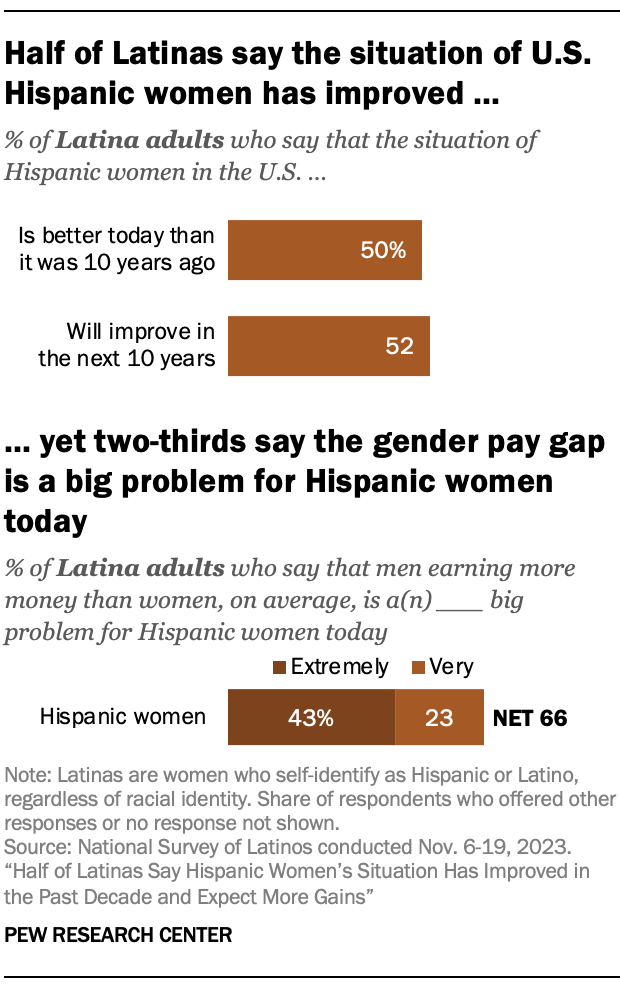
Still, 39% of Latinas say that the situation has stayed the same, and 34% say it will not change in the next 10 years. Two-thirds (66%) say the gender pay gap – the fact that women earn less money, on average, than men – is a big problem for Hispanic women today, according to new analysis of Pew Research Center’s National Survey of Latinos.
At 22.2 million, Latinas account for 17% of all adult women in the U.S. today. Their population grew by 5.6 million from 2010 to 2022, the largest numeric increase of any major female racial or ethnic group. 1
Latinas’ mixed assessments reflect their group’s gains in education and at work over the last two decades, but also stalled progress in closing wage gaps with other groups.
- Hispanic women are more likely to have a bachelor’s degree today (23% in 2023) than they were in 2013 (16%). More Hispanic women than ever are also completing graduate degrees .
- Hispanic women have increased their labor force participation rate by 4 percentage points, from 65% in 2013 to 69% in 2023.
- The median hourly wage of Hispanic women has increased by 17% in the last decade. In 2023, their median hourly wage was $19.23, up from $16.47 in 2013 (in 2023 dollars).
Despite this progress, Hispanic women’s pay gaps with their peers haven’t significantly improved in recent years:
- The gender pay gap among Hispanics persists with no significant change. In 2023, Hispanic women earned 85 cents (at the median) for every dollar earned by Hispanic men, compared with 89 cents per dollar in 2013 (and 87 cents per dollar in 2003).
- Hispanic women continue to lag non-Hispanic women in earnings , with no significant improvement in the past decade. In 2023, the median Hispanic woman made 77 cents for each dollar earned by the median non-Hispanic woman, compared with 75 cents per dollar in 2013.
- The pay gap between Hispanic women and White men has changed only slightly . In 2023, Hispanic women earned 62 cents of every dollar earned by non-Hispanic White men, up from 59 cents per dollar in 2013.
In addition, Hispanic women lag Hispanic men and non-Hispanic women in labor force participation, and they lag non-Hispanic women in educational attainment. Read more in Chapter 2 .
Among Latinas who are employed, about half (49%) say their current job is best described as “just a job to get them by.” Fewer see their job as a career (30%) or a steppingstone to a career (14%).
Pew Research Center’s bilingual 2023 National Survey of Latinos – conducted Nov. 6-19, 2023, among 5,078 Hispanic adults, including 2,600 Hispanic women – explores what it’s like to be a Latina in the U.S. today. This report uses findings from our 2023 survey as well as demographic and economic data from the Current Population Survey.
The following chapters take a closer look at:
- How Latinas view the progress and future situation of Hispanic women in the U.S.
- What government data tells us about Latinas’ progress in the labor market, earnings and educational attainment
- How Latinas’ educational and economic outcomes vary
For additional survey findings on what it means to be a Latina in the U.S. today and the daily pressures they face, read our report “A Majority of Latinas Feel Pressure To Support Their Families or To Succeed at Work.”
- Latinas’ population size and growth rate from 2010 to 2022 were calculated using the 2010 and 2022 American Community Surveys, accessed through IPUMS. The rest of the demographic analysis in this post uses data from the Current Population Survey. ↩
Sign up for our weekly newsletter
Fresh data delivery Saturday mornings
Sign up for The Briefing
Weekly updates on the world of news & information
- Economics, Work & Gender
- Education & Gender
- Educational Attainment
- Gender & Work
- Gender Equality & Discrimination
- Gender Pay Gap
- Higher Education
- Hispanics/Latinos
- Hispanics/Latinos & Education
Key facts about U.S. Latinos with graduate degrees
Hispanic enrollment reaches new high at four-year colleges in the u.s., but affordability remains an obstacle, u.s. public school students often go to schools where at least half of their peers are the same race or ethnicity, what’s behind the growing gap between men and women in college completion, for u.s. latinos, covid-19 has taken a personal and financial toll, most popular, report materials.
1615 L St. NW, Suite 800 Washington, DC 20036 USA (+1) 202-419-4300 | Main (+1) 202-857-8562 | Fax (+1) 202-419-4372 | Media Inquiries
Research Topics
- Age & Generations
- Coronavirus (COVID-19)
- Economy & Work
- Family & Relationships
- Gender & LGBTQ
- Immigration & Migration
- International Affairs
- Internet & Technology
- Methodological Research
- News Habits & Media
- Non-U.S. Governments
- Other Topics
- Politics & Policy
- Race & Ethnicity
- Email Newsletters
ABOUT PEW RESEARCH CENTER Pew Research Center is a nonpartisan fact tank that informs the public about the issues, attitudes and trends shaping the world. It conducts public opinion polling, demographic research, media content analysis and other empirical social science research. Pew Research Center does not take policy positions. It is a subsidiary of The Pew Charitable Trusts .
Copyright 2024 Pew Research Center

IMAGES
VIDEO
COMMENTS
But let's try. Over the next 25 years, genomic-driven analysis will continue to broaden the impact of personalized medicine in healthcare globally. Precision medicine will continue to deliver ...
The Research Futures Report 2.0 shows that the past two years have driven progress in both speed and openness in the communication of research. Around two-thirds (67%) of researchers globally now consider preprints a valued source of communication, up from 43% before the pandemic — a shift likely driven by the increased role of preprints in ...
The role of machine learning in clinical research: transforming the future of evidence generation. Trials 22 , 537 (2021). Article Google Scholar
This must be seen as a necessary part of genomics research, and will be key to its future. Commitments are also needed to improve the standards for data repositories. The repositories must be made ...
Abstract. Scientific research trends and interests evolve over time. The ability to identify and forecast these trends is vital for educational institutions, practitioners, investors, and funding organizations. In this study, we predict future trends in scientific publications using heterogeneous sources, including historical publication time ...
Advancing the future of scientific research. This Advertorial is brought to you by the Science /AAAS Custom Publishing Office. Research across all STEM fields is an iterative process. Whether it be incremental progress or a big breakthrough, today's advances are built upon the discoveries of the past. But to successfully incorporate the ...
The future of researchrevealed. The future of research. The research ecosystem has been undergoing rapid and profound change, accelerated by COVID-19. This transformation is being fueled by many factors, including advances in technology, funding challenges and opportunities, political uncertainty, and new pressures on women in research.
The future of research is also marked by scientific innovation, with new technologies and approaches being developed to address some of the world's most pressing problems. For example, gene editing technologies like CRISPR-Cas9 have the potential to revolutionize medicine by allowing scientists to edit DNA and cure genetic diseases. Similarly ...
The Future of Biomedicine. To achieve its goal of turning discovery into health and to maintain its role as the world's premier biomedical research agency, NIH must support the best scientific ideas and brightest scientific minds. That means looking to the future and ensuring that we have a strong and diverse workforce to catalyze discoveries ...
Envisioning the future of research. Watch the on demand webinar. To help you fulfill your goals in a landscape of increasing competition and complexity, Web of Science TM is building advanced resources and tools designed to accelerate the pace of discovery, increase the transparency and visibility of open research, better support strategic ...
Listen to the article. Futures studies is the systematic study of possible, probable and preferable futures. It can be used to help leaders and communities manage uncertainties and increase their resilience and innovation. We spoke with futurist Dr. Stuart Candy about the latest developments in this field and how it can help us solve pressing ...
Empowering Early Career Researchers. Future of Research champions, engages, and empowers early career researchers (ECRs) with evidence-based resources to make informed career choices and improve scientific research. Get Involved Donate.
Futures studies, futures research, futurism, or futurology is the systematic, interdisciplinary and holistic study of social/technological advancement, and other environmental trends; often for the purpose of exploring how people will live and work in the future. Predictive techniques, such as forecasting, can be applied, but contemporary futures studies scholars emphasize the importance of ...
6 priorities for future research into COVID-19 and its effects on early learning. Since March 2020, researchers have produced more than 300 reports on the effects of the COVID-19 crisis on young ...
The initially stated overarching aim of this research was to identify the contextual factors and mechanisms that are regularly associated with effective and cost-effective public involvement in research. While recognising the limitations of our analysis, we believe we have largely achieved this in our revised theory of public involvement in research set out in Chapter 8.
Future research can examine how cultural worldviews and global threats co-evolve. The pandemic has also amplified the demarcation of national, political and other major social categories.
While many books and articles guide various qualitative research methods and analyses, there is currently no concise resource that explains and differentiates among the most common qualitative approaches. We believe novice qualitative researchers, students planning the design of a qualitative study or taking an introductory qualitative research course, and faculty teaching such courses can ...
Futures Research. Futures research can be defined as a systematic study of possible future events and circumstances. As a field of study, futures evolved in 1950s. Futures research is different from forecasting in a way that the former has a forward orientation and looks ahead, rather that backwards, and is not as mathematical as forecasting.
The world has seen an explosion in aging research in recent decades, with billions of dollars spent by government agencies and private companies. And the consumer market for products is forecast to hit $93 billion by 2027. As a result, false or exaggerated claims by companies promising longer life are currently on the rise, Ramakrishnan noted.
Future Research: Further research could investigate the long-term effects of mindfulness-based interventions on mental health outcomes among individuals with chronic pain. A longitudinal study could be conducted to examine the sustainability of mindfulness practices in reducing pain-related distress and improving psychological well-being over time.
The Global Research Network is an MIT-led network of researchers, generating comparative international research to help reach data-driven conclusions on topics related to the work of the future and other relevant topics. View Project. Project | August 3, 2020.
Getting research onto the space station in the first place takes time, too. NASA reviews proposals for scientific merit and relevance to the agency's goals. ... Selected investigations are assigned to a mission, typically months in the future. NASA works with investigators to meet their science requirements, obtain approvals, schedule crew ...
New Stanford research shows that, over the past century, linguistic changes in gender and ethnic stereotypes correlated with major social movements and demographic changes in the U.S. Census data.
The research highlights the importance of staying ahead of the curve in technology. Companies that embrace digital technologies now are likely to be the ones that thrive in the future. And while there are still many unanswered questions about how these changes will play out, one thing is clear: The relationship between technology and business ...
The bioengineers of the future must not only promote technical excellence, but also foster equity, ethics, dialogue and social responsibility in how the fruits of their research are deployed.
St. Jude Children's Research Hospital. St. Jude Children's Research Hospital is leading the way the world understands, treats and cures childhood cancer, sickle cell disease, and other life-threatening disorders. It is the only National Cancer Institute-designated Comprehensive Cancer Center devoted solely to children. Treatments developed at St. Jude have helped push the overall childhood ...
Decades of NIMH-supported basic research led to a pioneering treatment for postpartum depression and continues to power exciting advances in women's mental health care. ... This finding opened the door to future studies exploring whether a postpartum drop in the neurosteroid contributed to the risk for mood disorders after birth.
In this issue, we present a Focus dedicated to the future of cancer research, in which we take stock of progress and explore ways to deliver research and care that is innovative, sustainable and ...
The research highlights the importance of staying ahead of the curve in technology. Companies that embrace digital technologies now are likely to be the ones that thrive in the future. And while there are still many unanswered questions about how these changes will play out, one thing is clear: The relationship between technology and business ...
The first is a Pew Research Center survey of 5,078 Hispanic adults, including 2,600 Hispanic women. Respondents were asked whether U.S. Latinas saw progress in their situation in the last decade, whether they expected any in the future decade, and how big a problem the U.S. gender pay gap is. The survey was conducted from Nov. 6 to 19, ...